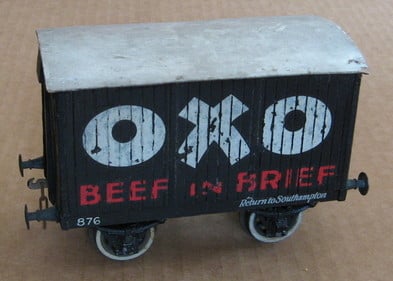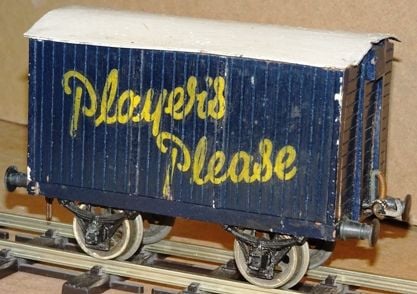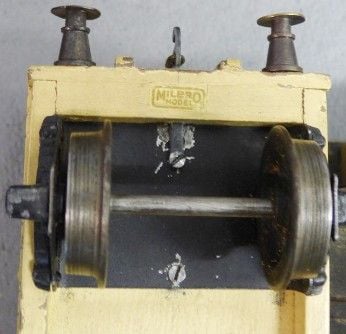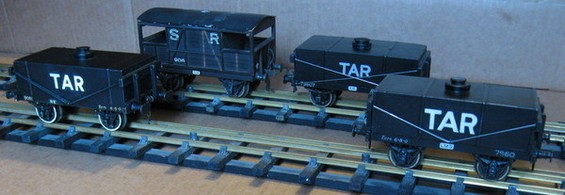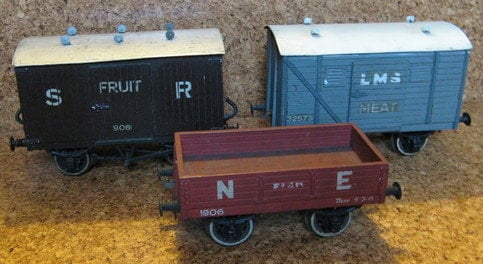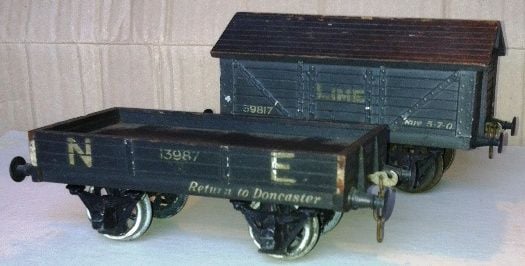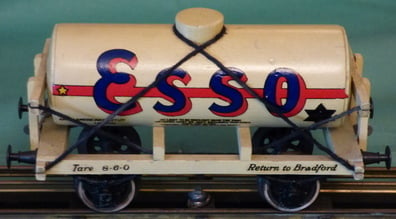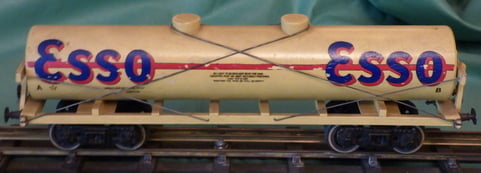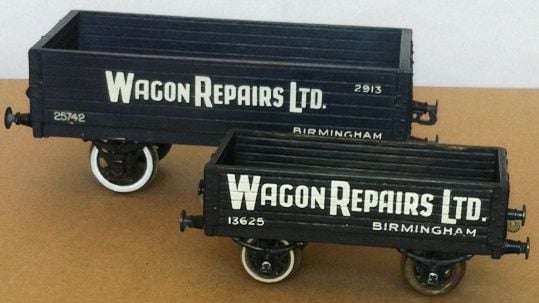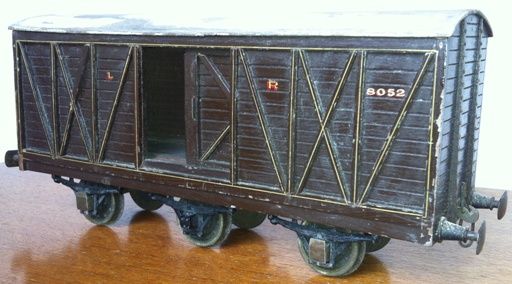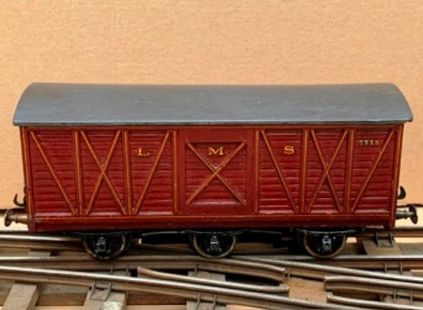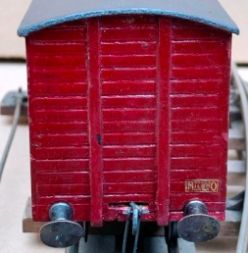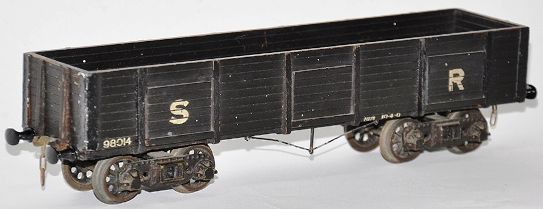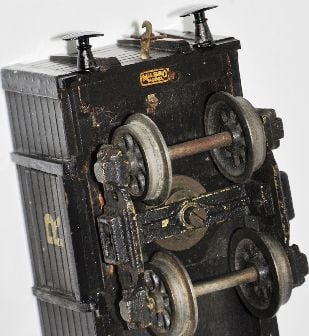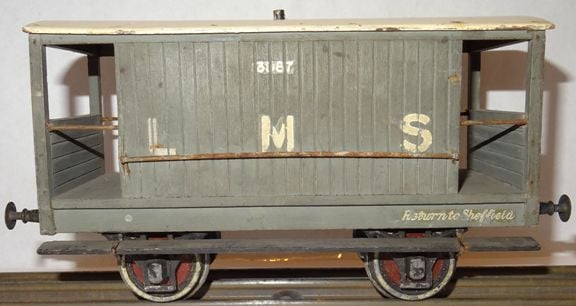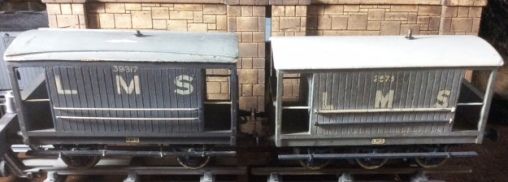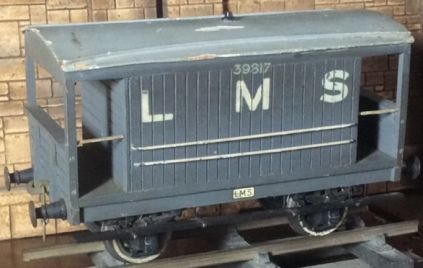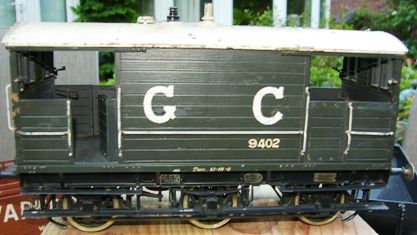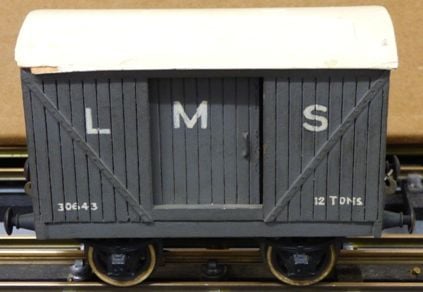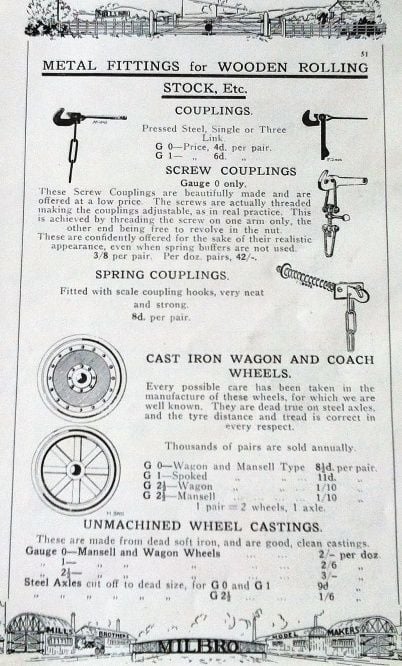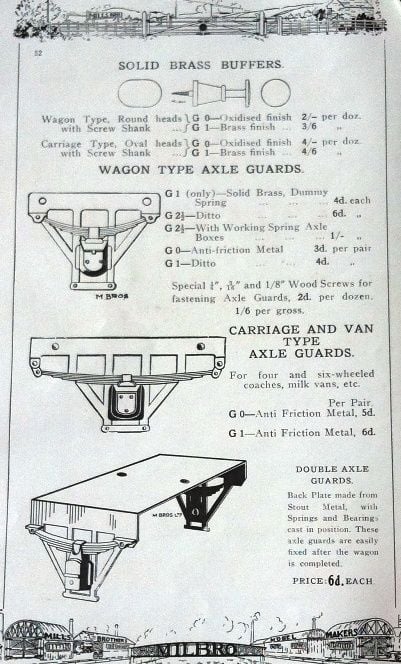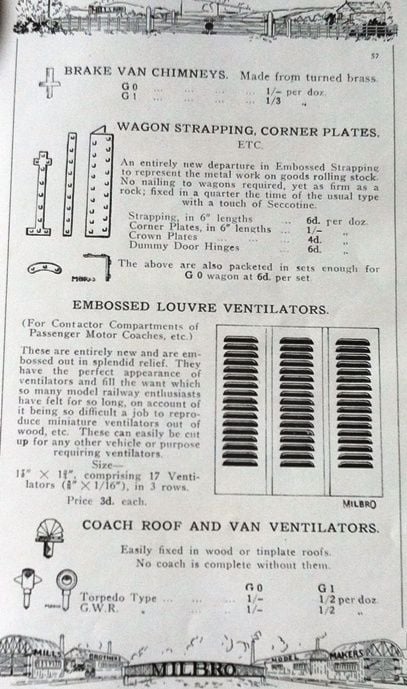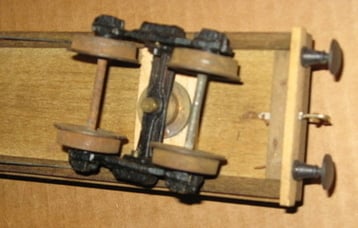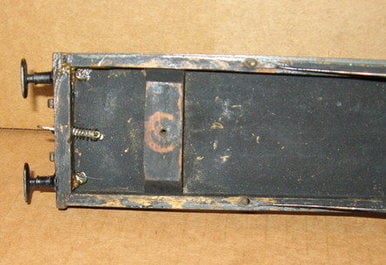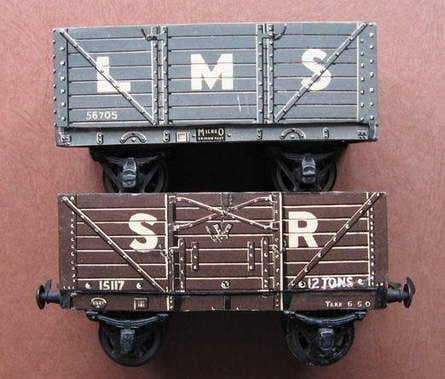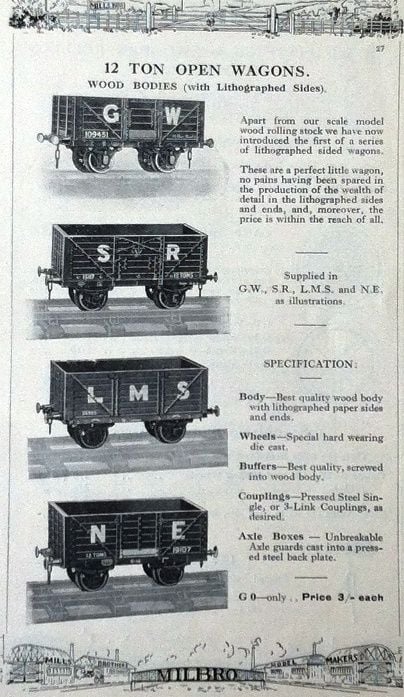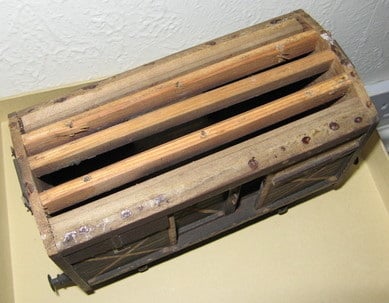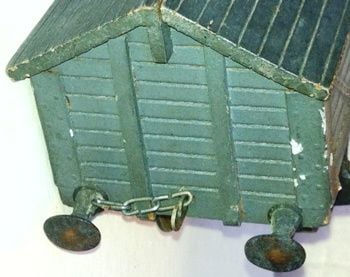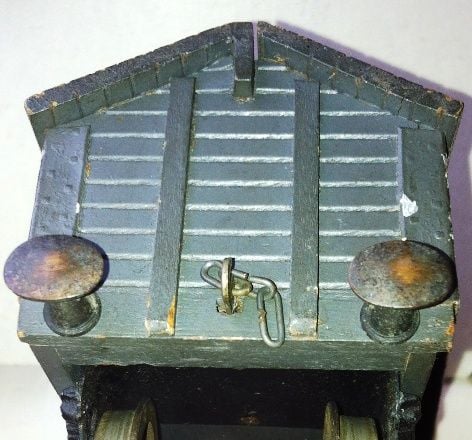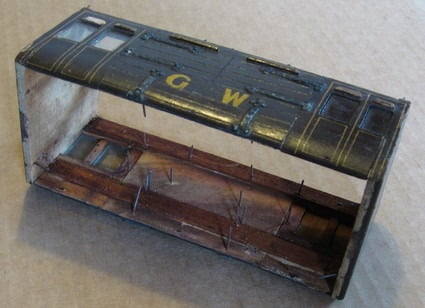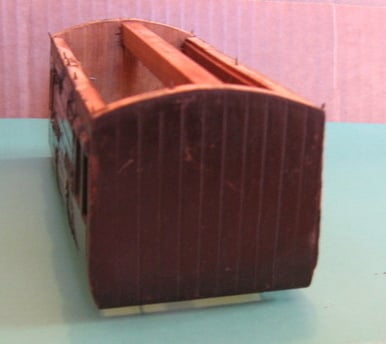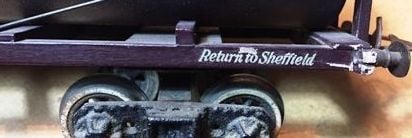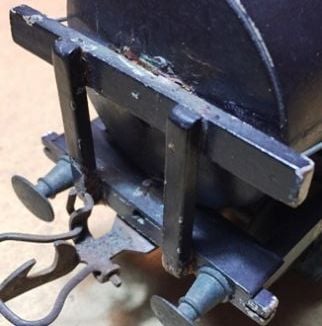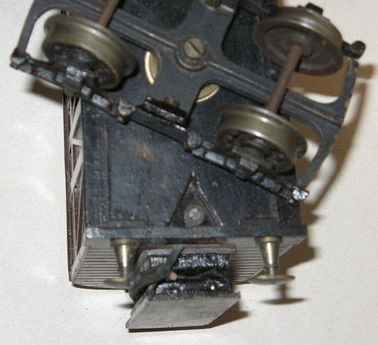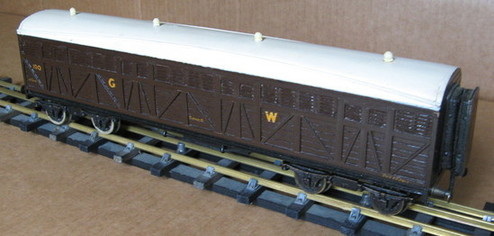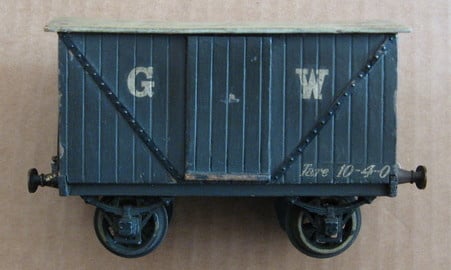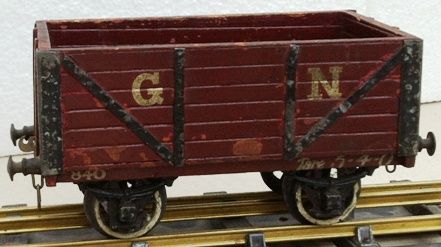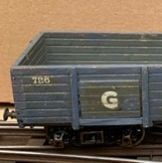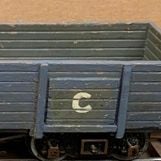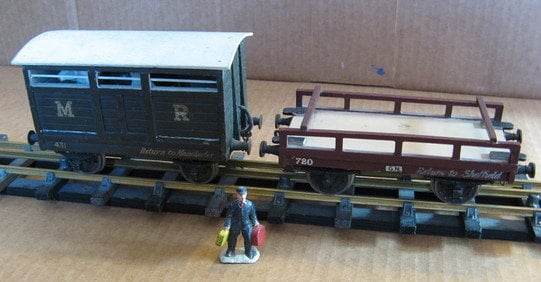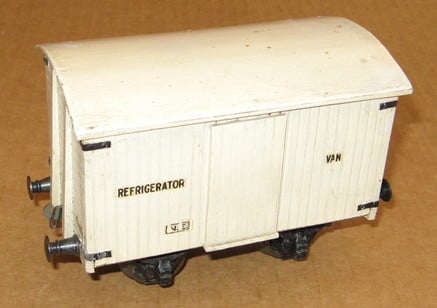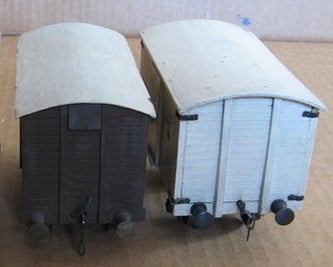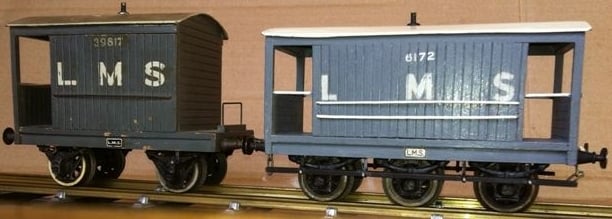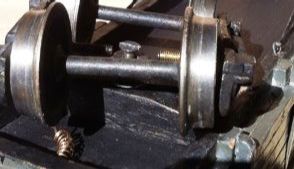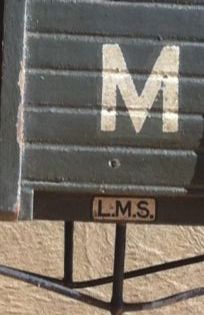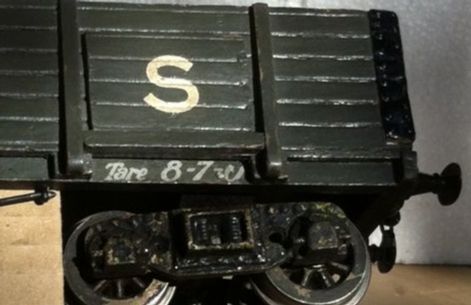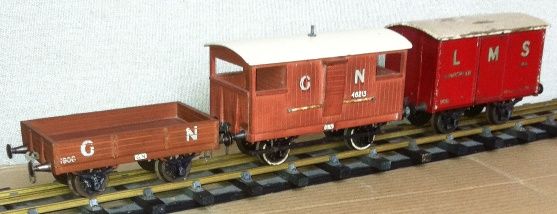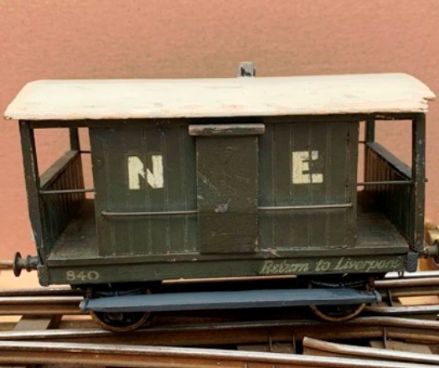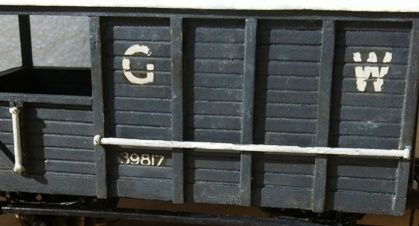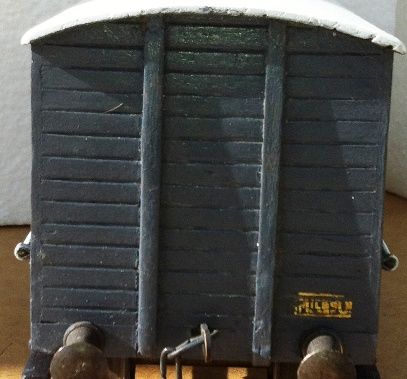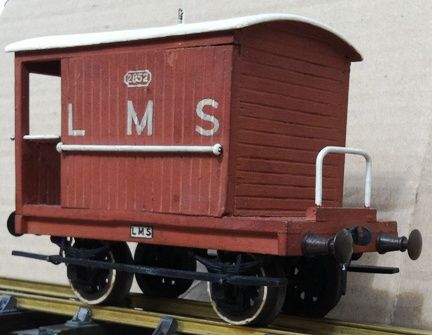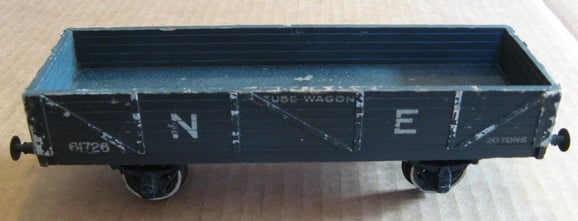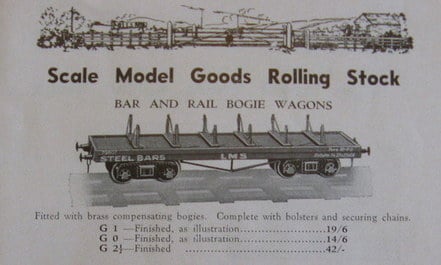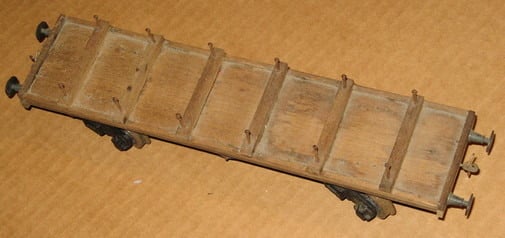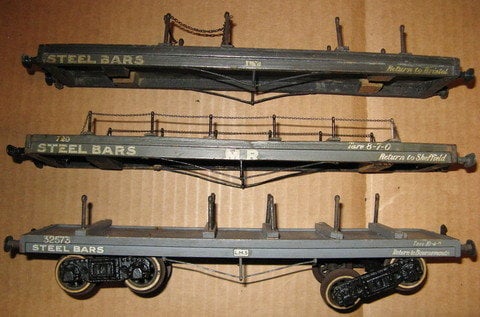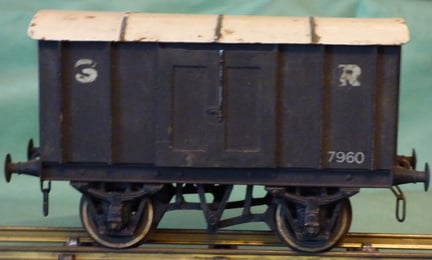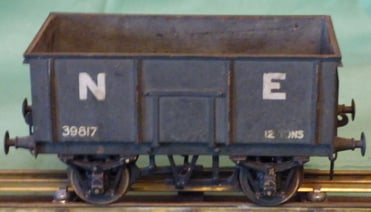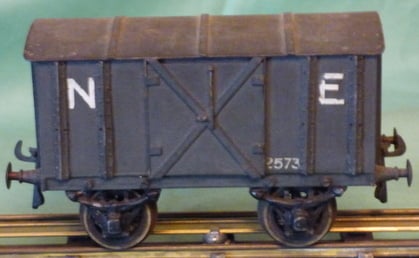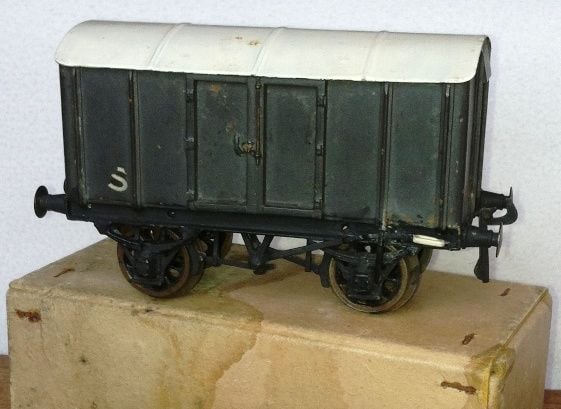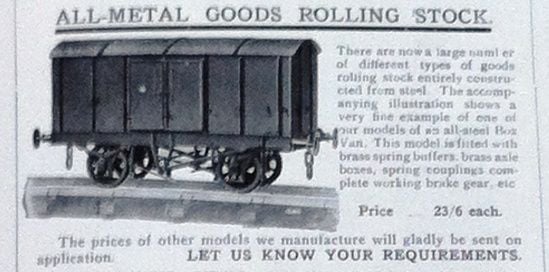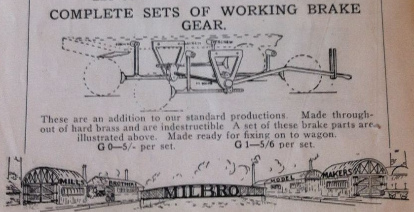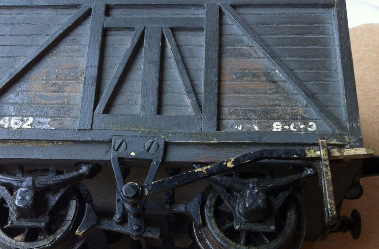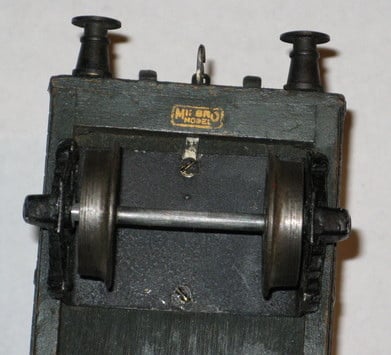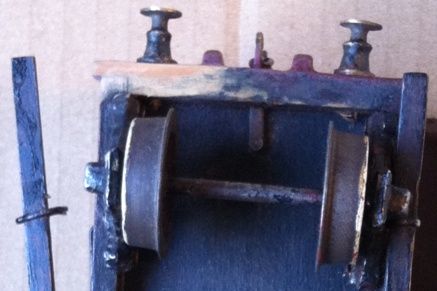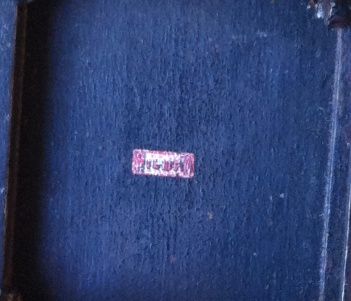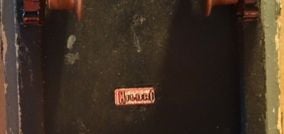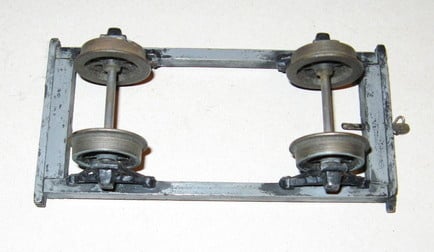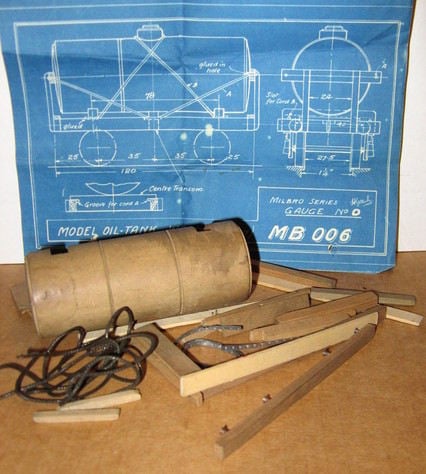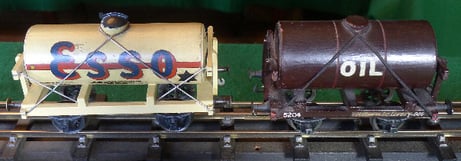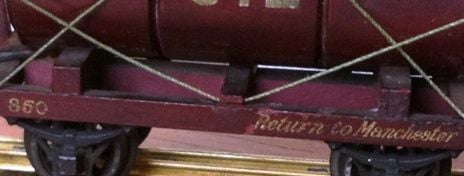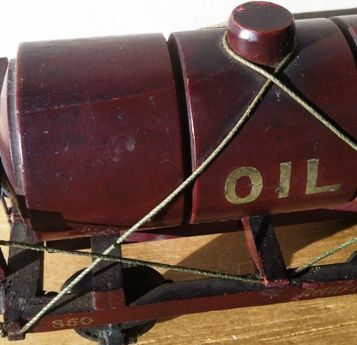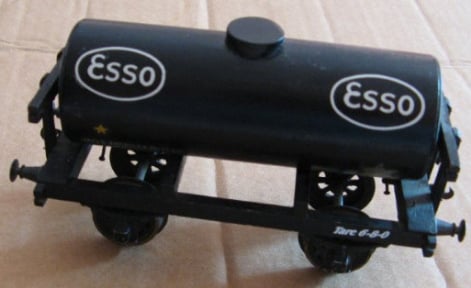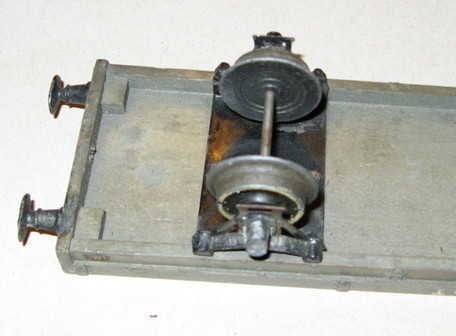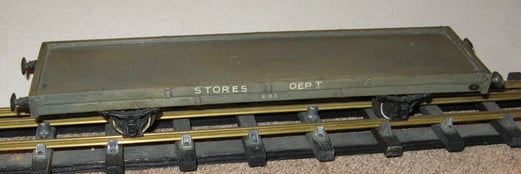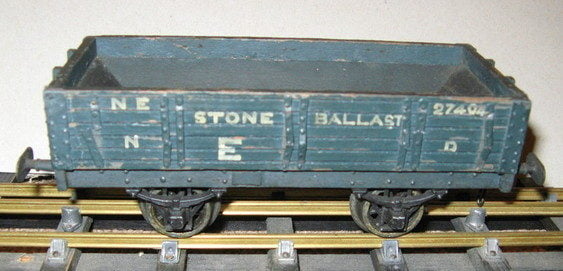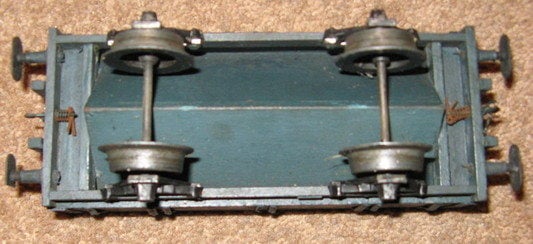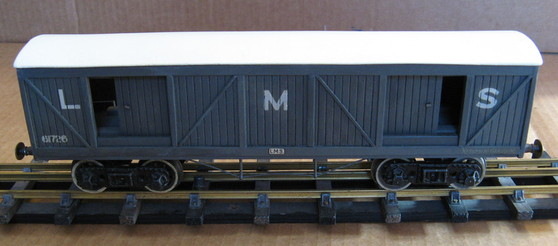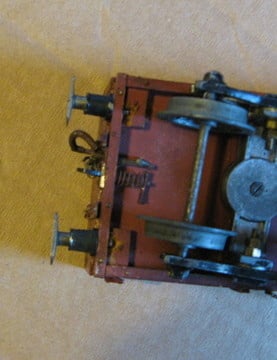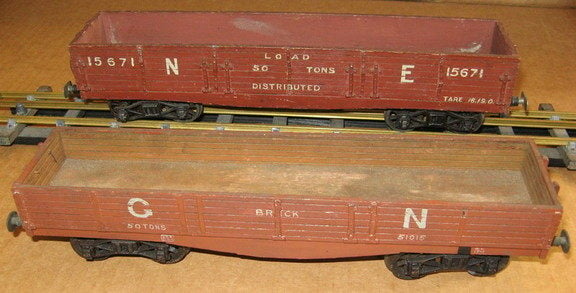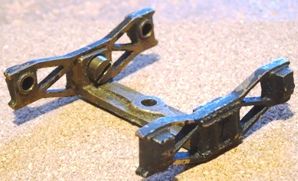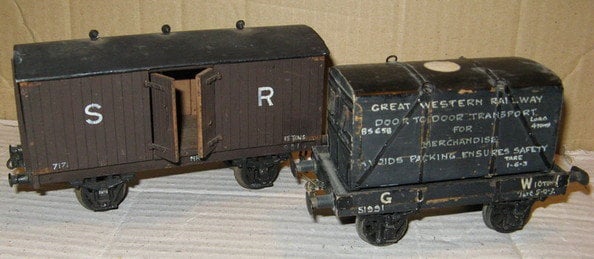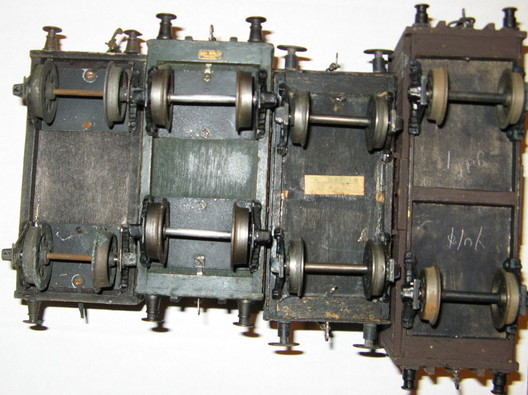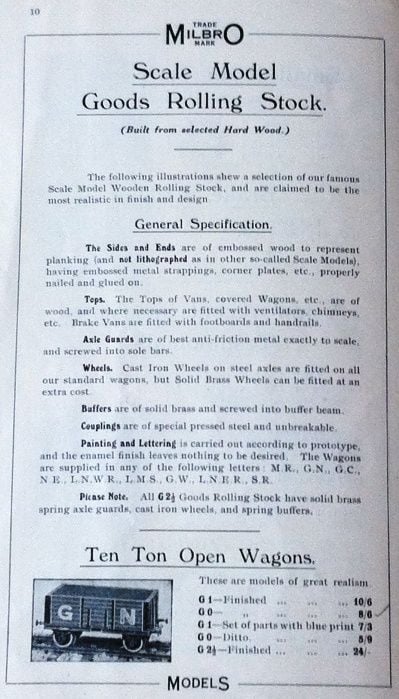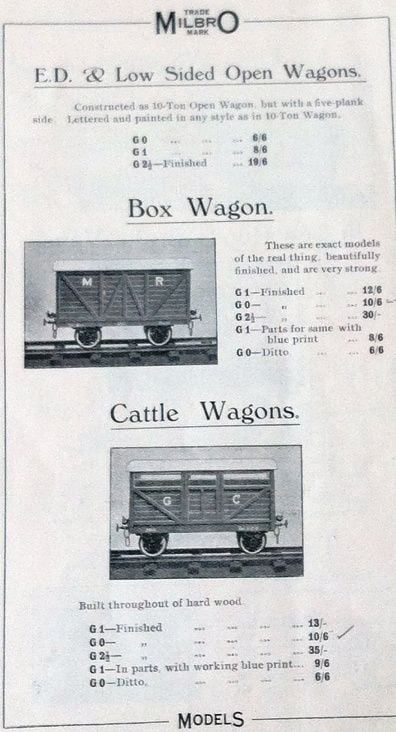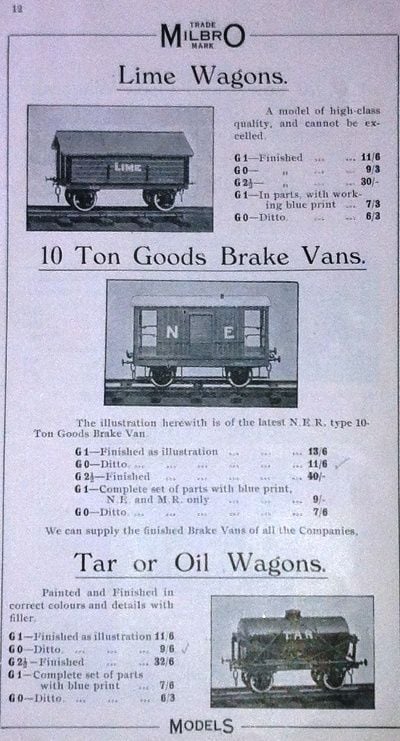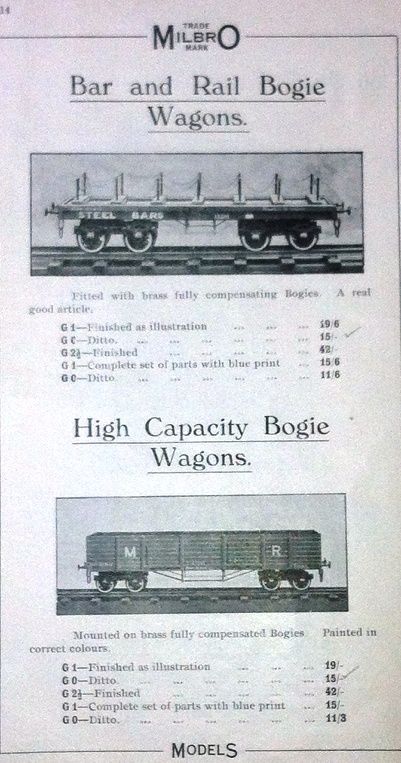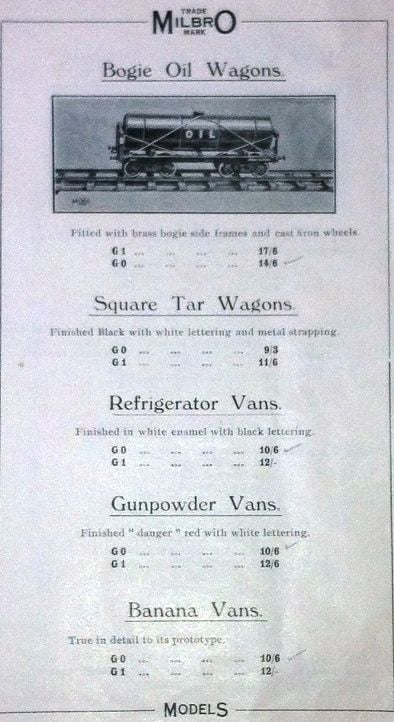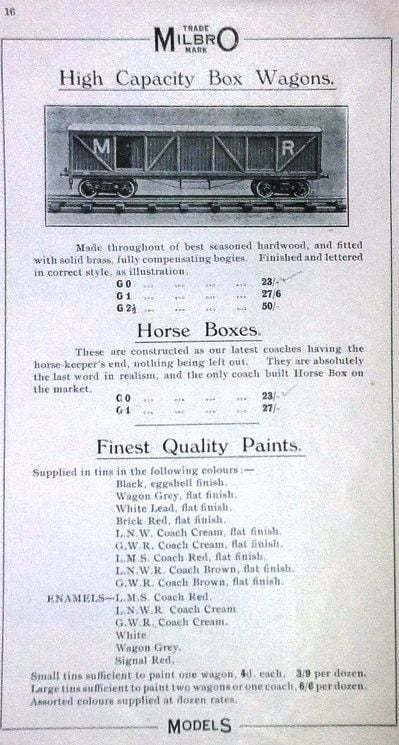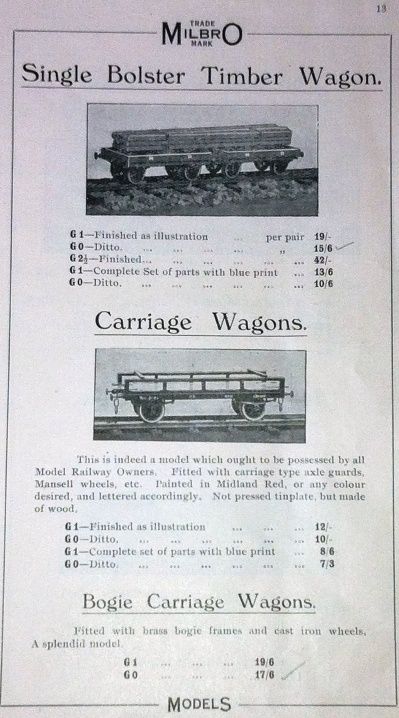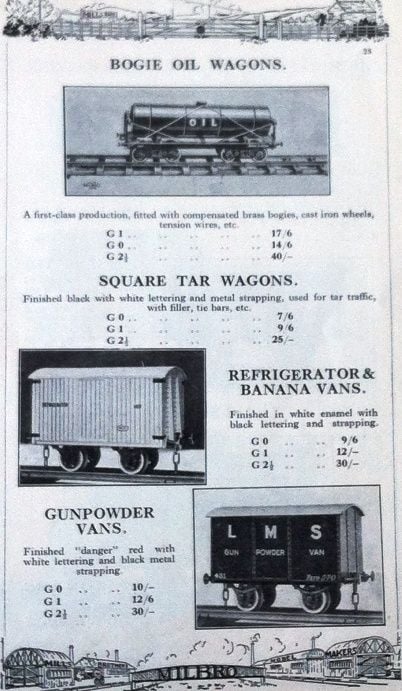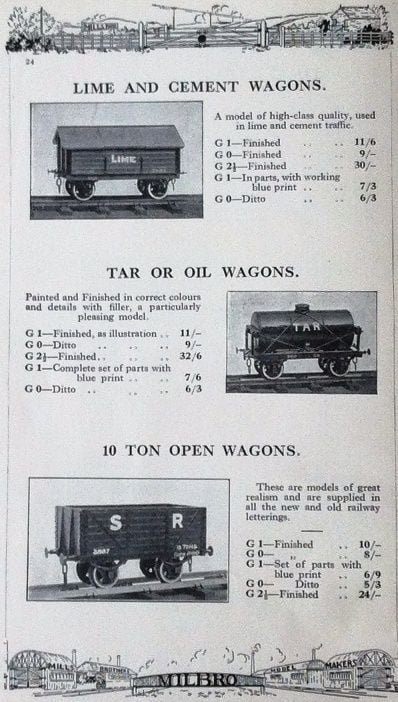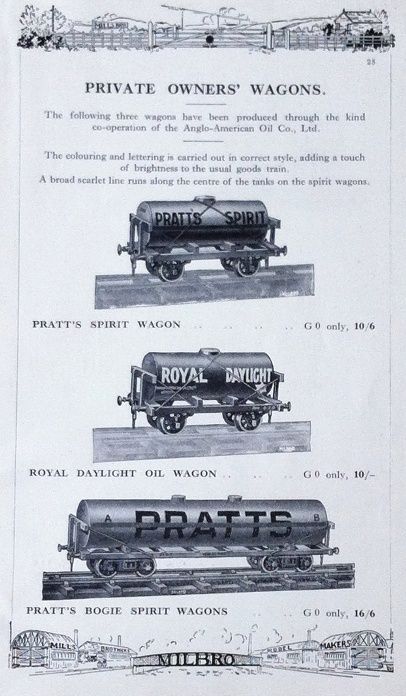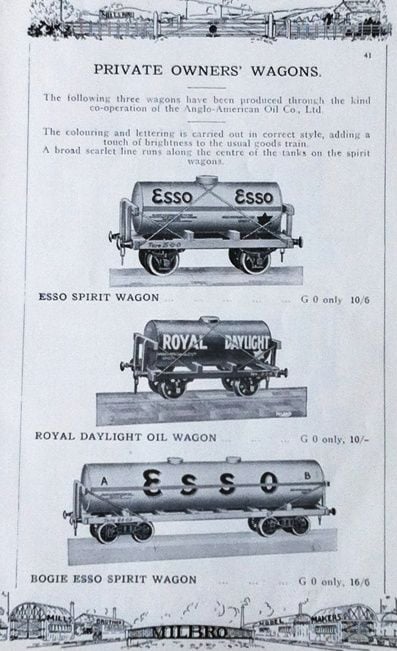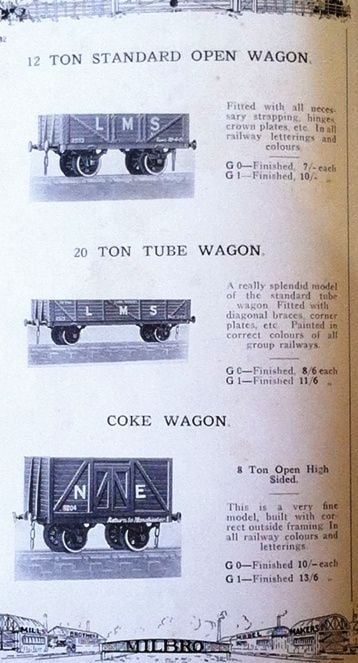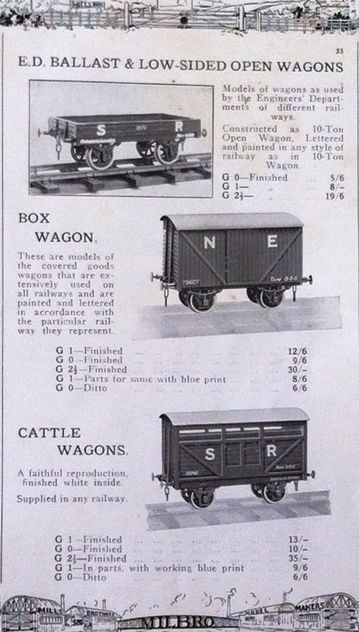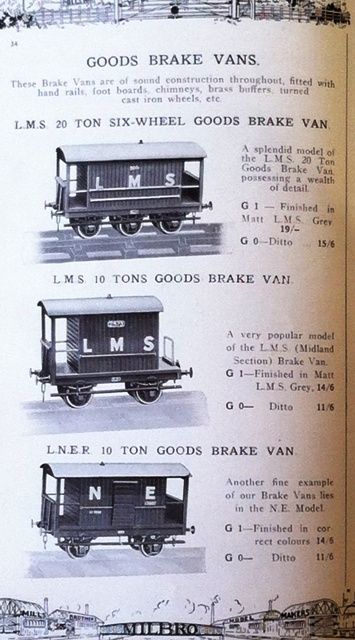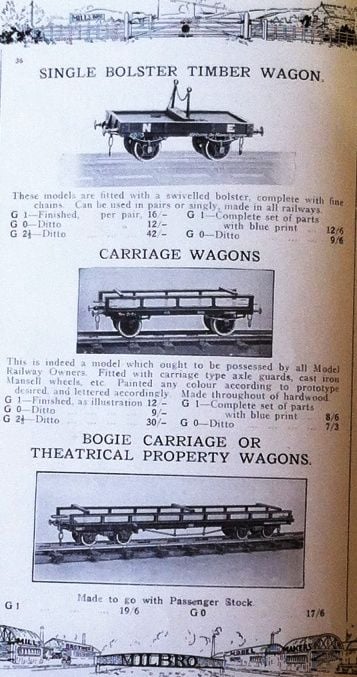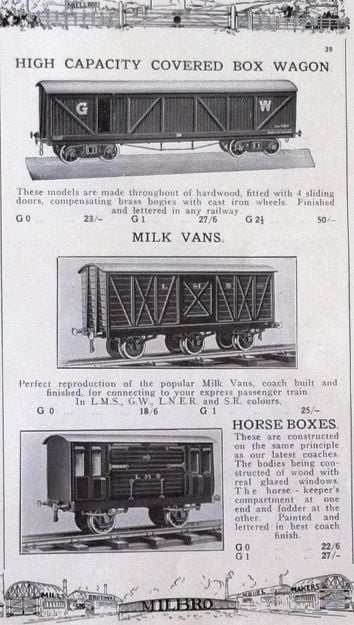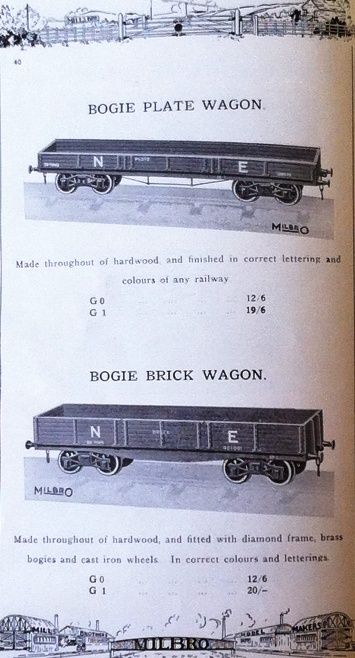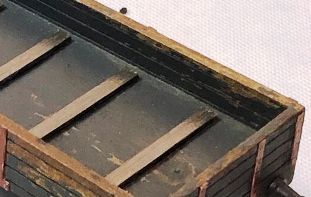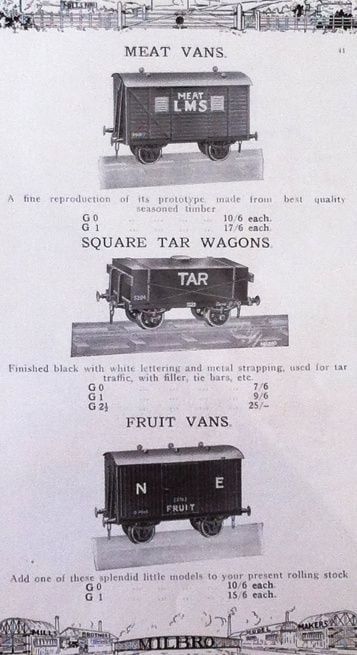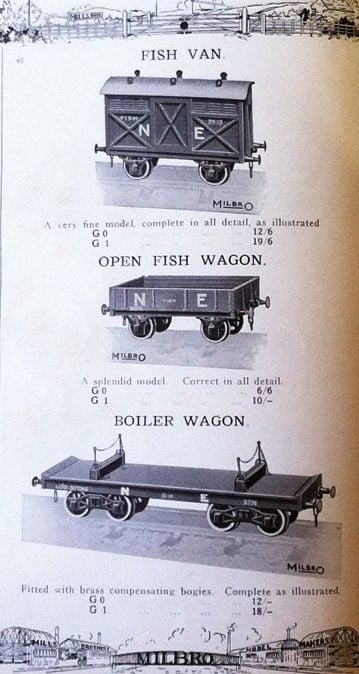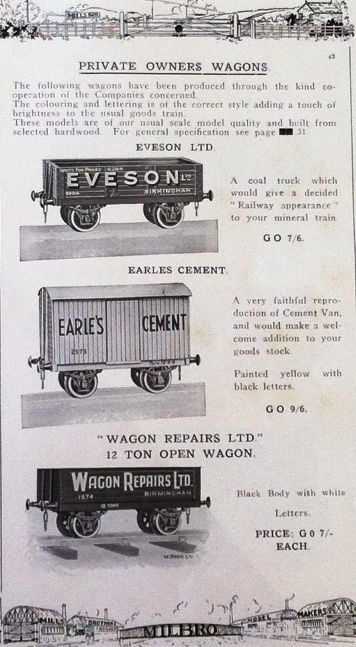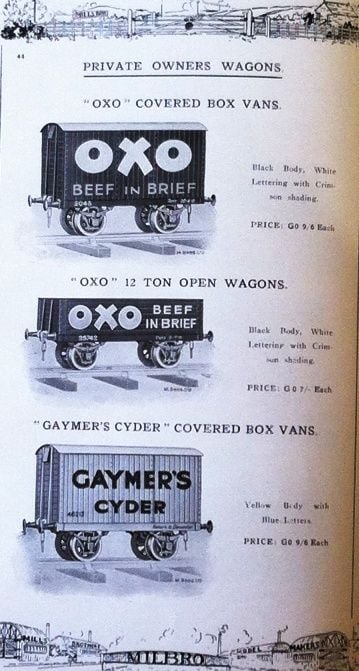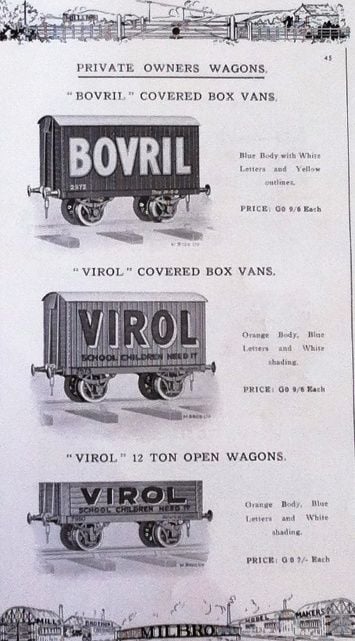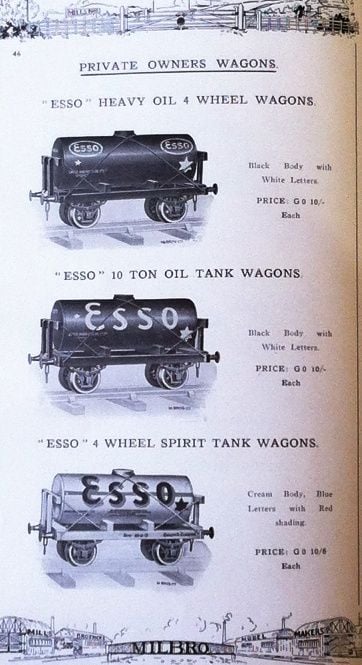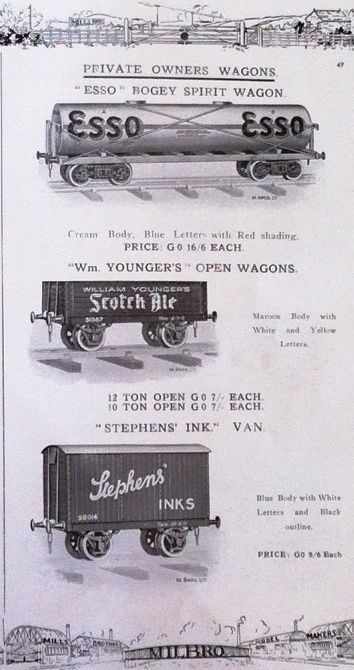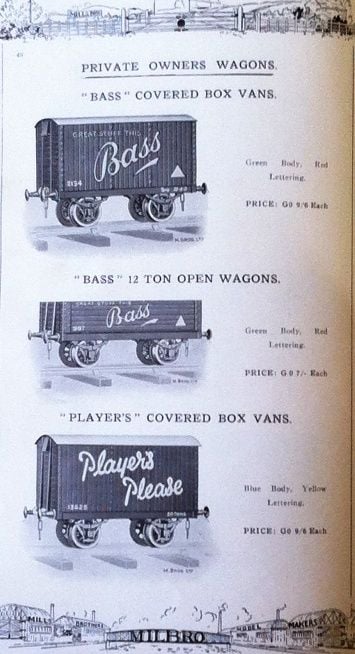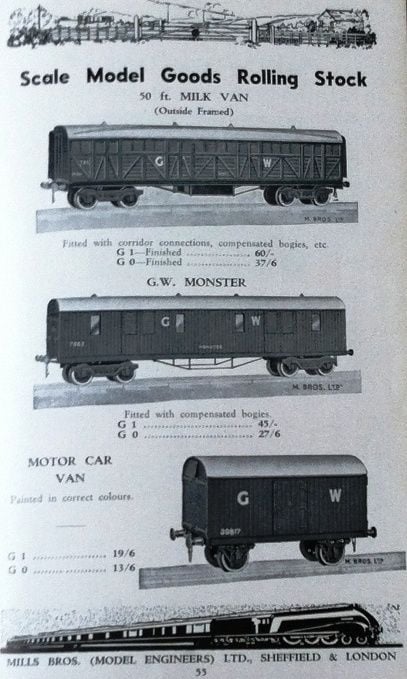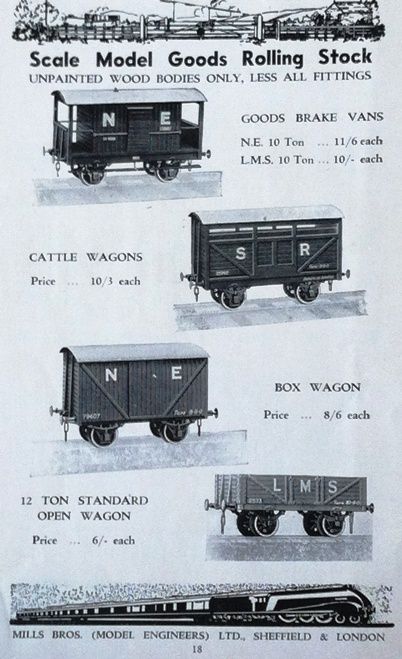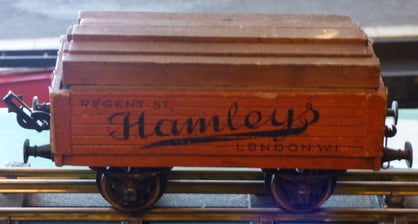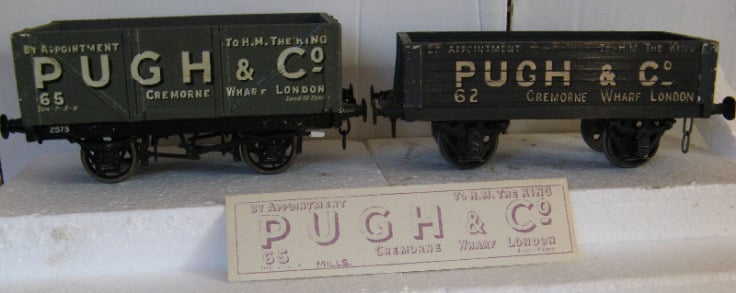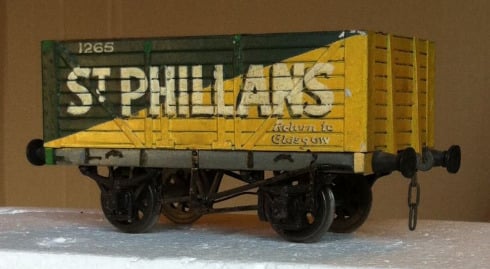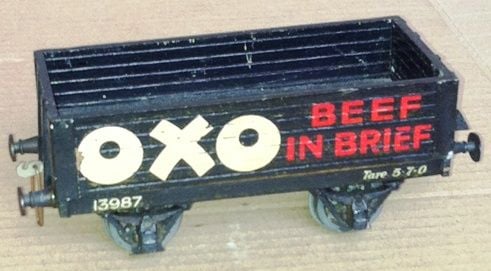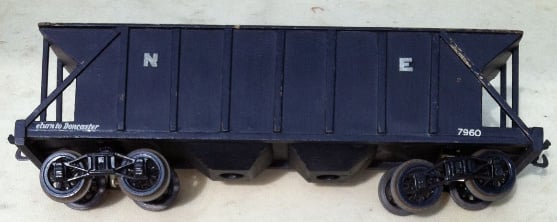
Milbro Wagons
**** Material updated most recently in this section in October 2025 ****
A REVIEW OF WAGON TYPES AND FEATURES Copyright is retained by M.L.Harrison for all text and photos, except for those taken by other owners and enthusiasts. M.L.Harrison 2020, 2025 © All rights reserved.
This wagons section was first available from March 2014, and has been enlarged and improved since then. Although the section is primarily about wooden wagons, there is also brief coverage of the rare metal vehicles built by Milbro. See also our Gallery page for more wagon photos.
A few opening examples from the wagons range
Illustration W1. One of the factory-produced Milbro 0 gauge Private Owner vans. These have handsome transfers, and often seem in demand amongst collectors. We show the firm's range of private owner transfers in our page about Artwork.
Illustration W1a. Another example from the same series. This seems to have had some hard use, and the roof needs restoring. I rather like the faded lettering and this shade of blue.
Illustrations W1c and W1d. This private owner van is not one of the firm's standard transferred vehicles, but seems very consistent with what might be expected for a special order item. I think it was most likely commissioned either from the Mills factory or via a recommended sub-contractor or retailer (such as W & H). It is very rare to find such a convincing addition to the private owner range, and I am grateful to the enthusiast who sent me the photos. Of course, it is conceivable that an individual trains operator or professional has repainted one of the Milbro standard PO versions (although as the model came from a very longstanding collection that might seem less likely).
Illustration W1e. Another of the firm's regular range. It looks as if there may have been some work by an enthusiast in the past to repair some of the transfers here, and maybe parts of the paintwork too. So some minor tidying now could help improve the model. We should add that non-factory versions of the private owner wagons turn up, including some made in relatively recent periods using other standard wagon parts or bodies. The firm itself offered kits and transfers, so these items certainly are part of the Milbro 'tradition', although some collectors prefer to seek out ones that are factory items.
Illustration W1f. The Bass version, which is complemented by an open wagon (below).
Illustration W1g. An example of the open wagon type (note the lack of strapping).
Illustrations W1h and W1i. Another of the private owner box vans. This is a factory version that has probably been partly refinished or touched in quite a long time ago. The slight damage within the area of the Tare number is most likely from a fitting that was added and later removed (and that damage is duplicated on the other side of the wagon). The original wheels have been replaced (and that needs putting right).
Illustration W2. Three Tar Wagons with a Southern Brake. The brake needs some repair and restoration, but the tar wagons have been renovated. Two of them had been heavily over-painted by a previous owner. All have had a filler cover added at some stage, and one has a small non-Mills NE transfer. The wires on the sides on one are in the style shown in catalogues, but the other arrangement seems the more regular one in Gauge 0.
Illustration W3a. Three examples of gauge 0 vehicles for specific goods traffic; a Southern Fruit Van, LMS Meat Van, and NE Fish Truck. Milbro used some embossed louvre ventilator panels on these two vans. The factory versions of the Fish Truck often (like this one) differ slightly from the catalogue picture, but there is also a factory version that matches the catalogue (and has a little more strapping on the sides).
Illustration W3b. Another Mills vehicle for specific traffic, the Lime Wagon, here shown standing behind a small NE open wagon. The latter could do with some minor restoration and better wheels. The Lime Wagon exemplifies the simple but robust construction style adopted by Mills (for its specific features see below, Illustrations W9b, W9c and W9d). I think that some earlier versions may have additional markings (or actual divisions) on their roofs, to represent an opening centre panel on each side.
Illustration W4a. A very good model from the 4-wheel spirit/oil wagons range. [With thanks to the owner for providing this picture and the next one.] This is in exceptional condition.
Illustration W4b. One of the large 0 gauge bogie spirit/oil wagons from the later period of production. Another 'Esso' version, a 'Pratts' vehicle and plainer 'Oil' types were also made (the latter being black or red/brown). A black Oil one is shown immediately below. I have also seen examples of an earlier catalogued bogie Oil type which had 'channels' for some of the ropes or wires (or soft metal strips) to run in (see also below, W33 and W34b-34d), but do not have a picture of this in 0 gauge at present. Catalogue images are however included in Illustrations W47 and W48 below, and an early Gauge One example may be seen in the Gallery section of this site. Wagons like that shown above have been very sought after by collectors. See Illustrations in the Artwork section of this site for the the transfers used on these. The details can vary on the large spirit/oil wagons (as our next illustration shows). There may be two rather than four retaining wires or ropes on the 'blonde' ones as well as on a black one. Perhaps this might reflect when a wagon was made.
Illustration W4c. A black Oil version of the same type of vehicle as in Illustration W4b. Unusually, this particular model has only one vertical wooden cylinder inserted into the top of its tank. In that respect it is similar to the catalogued earlier type mentioned above, although apparently of the different (later) design. It could conceivably be a wagon produced as a transition form when the firm stopped modelling 'channels' in its Oil wagons, but retained the old illustrations of these vehicles. Thanks are due to the enthusiast who sent me some photographs of this 0 Gauge wagon; see below for more illustrations, W11a-W11c.
(This photograph of the end of the vehicle makes the maroon colour look a little brighter than it should.)
Illustrations W4d and W4e. This wagon was offered earlier in the 1930s than the cream-coloured ones shown in Illustrations 4a and 4b above. Two others were catalogued at the same time as this Royal Daylight version; a Pratt's 4-wheeler and a Pratt's bogie vehicle. The rare Pratt's bogie version is shown in our Gallery page, and the 4-wheeler can be seen in our Artwork page..
Illustrations W4fi and Wfii. This wagon features another of the sets of transfers Mills made for their spirit vehicles. I do not know if the factory's 'standard' wagon body carrying these particular transfers would have had the firm's cream colour or have been their grey version. I have had the above item a very long time and cannot recall much about its history. I do not know whether it was factory-made, a modified factory version, or assembled from a kit. I did some restoration on it in the past, and there is more to do. Unfortunately, in trying to carry this forward more recently I found my old replacement transfer sections inclined to break up badly when applied! As can be seen, I have not yet fixed on any of the strings or wires needed. I'm not sure what the firm would have most often used when items were new, but we show later two examples of material that came with an early kit and are very thin. Actual wires have sometimes been added but seem less likely to have been factory-fitted. In our page on Artwork we show the various transfers that were available. Some Mills wagons seem to have been particularly attractive to enthusiasts who wanted to rebuild or enhance them for their layouts. Perhaps Spirit and Oil wagons proved especially worth altering for these 0 gauge modellers, as over the years I have seen quite a few with changes (including a dreadful repaint with thick silver paint). The one below seems likely to have been a factory version that was then 'super-detailed' and given very small wheels.
Illustrations W4gi and W4gii. This wagon probably started as a standard factory version, but an enthusiast 'super-detailed' it. There is quite a lot of paint debris of some sort on parts of the body, but even so the model should be fairly easy to bring back close to its original form. We showed this item also on our Home Page.
Illustration W5a. Gauge 1 and Gauge 0 Milbro private owner wagons. As can be seen, standard 0 gauge transfers have been used for the company name on the larger vehicle here, when it was repainted by its owner (see also our Artwork section for further photos).
Illustration W5b. Another Gauge One vehicle. When photographed this was awaiting some minor restoration to its lining and to the paint on the roof. It was one of three Milk Vans supplied with opening doors by Milbro as part of a group of special order wagons delivered near the start of World War Two, for the owner of a model railway in the North of England. I believe it was probably far more common to have features like these doors added to standard vehicles in this size rather than in Gauge 0. Variations in the features of standard box vans also seem much more likely in Gauge One, and an example of what I think is an uncatalogued type is shown in the next picture. The Milk Van above has some sprung axle boxes. See also the Gauge One bogie box van and other vehicles shown in our Gallery section, which were commissioned for the same model railway in the North of England. In the Gallery I have included two examples of the correspondence from Milbro about the wagons that were being supplied.
Illustrations W5c and W5d. A standard Gauge 0 version of the Milk Van, in this case with LMS livery. Thanks to the owner of this model for sending the two pictures. We show more milk vans in our Gallery section.
Illustrations W5e and W5f. Thanks are due to the enthusiast who has provided these useful images of a High Capacity bogie vehicle in Southern livery. The type of brass bogie pictured here is probably the one most often used on Milbro bogie wagons, although the firm's other freight type is sometimes found, and occasionally use was made of Milbro 'American' coach bogies (see later below for further discussion). The lower picture here also shows what is probably the commonest version of the Mills brass fitting that holds the bogie to the wagon. In an earlier period a simple piece of shaped wood was used instead (and we illustrate this later below).
Illustration W5h. I am grateful to the owner of this Gauge One van for letting me have this photograph. The wagon is a good example of a vehicle with external framing that seems to differ from catalogued forms. I have seen other similar variations in this Gauge.
llustration W5i. Thanks also to the photographer who sent me some pictures of this Gauge One LMS vehicle. I have not seen any catalogue picture of a Mills 4-wheeled LMS brake with this body shape, but there are similar variants in Gauge 0 (see below). Two photographs of details from the above wagon are shown in our Gallery section of the website. It has its Milbro transfer and I am informed that there are no signs of it ever having had a third (central) pair of wheels.
Illustrations W5j and W5k. Many thanks to the collector who sent me these pictures of 0 gauge vehicles. The uncatalogued 4-wheel brake van featured here has close similarities with the catalogued 6-wheeler shown with it. I have a similar 4-wheeler (although in much poorer condition!). Both 4-wheelers are factory models with Milbro (trademark) transfers, but (like the Gauge One vehicle pictured above) have no evident holes drilled for a central pair of axle-boxes. My guess is that customers asking for a 4-wheel version of this type of brake usually would be catered for without a change of body shape or size, unless something more specific was requested.
Illustration W5l. This is a much larger brake van, made by Mills Brothers for a railway with three and three-quarter inch gauge track. Such vehicles are extremely rare from any model railway maker, and (as can be seen here) can embody realistic features and detailing not generally attempted in the smaller scales by vintage builders. I am grateful to the owner of this vehicle for letting me show it here, and for pictures of further wagons from the same group that we show in our Gallery section. I am informed that the models were made for G.H.Swann, and were referred to in a magazine article in 1943.
Illustration W5m. I have never seen another O gauge 4-wheel standard wooden van like this one, where the door has been made to open, as with some of the Gauge One versions. It may well be a factory product to meet an order (albeit then probably re-transferred), or perhaps a kit-built model (where the owner created the sliding doors). Either way, it is very much in keeping with the Mills style, and thanks are due to its owner for letting me have this image.
The discussion below is divided into the following sub-sections:
Standard practices, economy and the lithographed wagons Construction, deterioration, coach-style features and paintwork Continuity and diversity; from kit to model to imitation (a small 'case study') Transfers for numbers, tare numbers and 'return to' labels Comparisons with products from other companies; Leeds, MRCo and R Models of Cheltenham The catalogued wooden wagon types
Wagons in the wooden range were assembled from standardised parts, with very neatly impressed (or perhaps scribed) markings for planking. The quality of Milbro wagon wood is usually high, and products range from very simple to quite complex in constructional terms. Trade mark transfers may be seen on some of the factory-produced models. There is an early mark with red as its dominant colour. Later plain gold ones seem to come in two forms, comprising either the words ‘Milbro Trade Mark’ or ‘Milbro model’ (probably depending on period of manufacture). I have also been informed of a gold Milbro label on a black ground. It seems that a variety of wagons were made from the earlier years onwards in Gauges 0, One, and Two-and-a-half. Later on, some items (such as specific private owner vehicles) were offered only in Gauge 0, while others may perhaps have been available only in Gauges 0 and One. It looks as if references to the largest scale had diminished in relative importance within catalogues by the late 1930s, but the company was still able to supply bogies, wheels and axle guards for this size of wagon. Despite the apparent relative rarity of large scale layouts and enthusiasts, Milbro clearly maintained some kind of commitment to that market over a long period, but examples of Mills vehicles larger than Gauge One nonetheless must be extremely rare. We are however lucky to be able to show one very large brake van above, and some related superb wagons in the Gallery section. The lengthy catalogues of the late 1930s show an extensive range of vehicles, including several kinds of open wagons and box vans, a cattle wagon, brake vans, a lime wagon, a milk van, heavy oil or spirit wagons, and what are described as ‘square tar wagons’ (see above). Catalogue extracts are included below to show the variety (see Illustrations W47-W48). The Milbro range in this period also included their striking private owner wagons for which transfers still turn up. For these vehicles the 1937/38 catalogue showed open wagons labelled Eveson, Wagon Repairs Ltd, OXO, VIROL, Scotch Ale and Bass. Box vans shown were Earle’s Cement, OXO (see above), Gaymer’s Cyder, BOVRIL, VIROL, Stephens’ Ink, Bass (see Introduction Illustration 3) and Player’s Please (also see above). In addition, Hammond's guide mentions a Hamleys open wagon (Ramsay's British Model Trains, 7th edition, 2011, p. 365), and the existence of a batch of wagons with this transfer was confirmed by a letter from John Ingram to the Bassett-Lowke Society Newsletter in Winter 2004 (14, 2, p. 10). A picture of one of the Hamleys wagons by Milbro is included as Illustration W50 below. I also deal there with another authentic Milbro private owner open wagon for which I have seen no catalogue picture but for which transfers were made. This is the grey PUGH & Co wagon (see Illustration W51). I have added to these an example of an over-painted private owner wagon livery which is very much what might be expected from factory or commissioned work (via a special order from Mills or another retailer), although I understand that this vehicle perhaps may more likely have been made from a Mills wagon (along with some others) by a skilled individual enthusiast for his own use. Near the start of this page I have placed two pictures of a very convincing van with a different livery that seems very likely to be a special order item. Milbro four- and six-wheel Gauge 0 wagons generally have soft metal axle guards, although I have some examples for Gauge One where brass fittings were specified instead. Axle guards were normally either attached individually by screws, or paired on metal plates (as for LMC products), and a longer type of axle guard appears on some items such as the horse box. This fitting is the ‘carriage and van type’, which may be found also on Milbro’s four- and six-wheel coaches. When a wagon turns up today complete with its original wheels, these are usually of the heavy cast iron type shown in catalogues, and occasionally may be the coach (Mansell) version. On a six-wheel vehicle the centre pair of a set may be without flanges. The company also sold unmachined wheel castings. Solid brass wheels were available too, at least in the period when the earlier catalogues were produced, but I only have 2 pairs of brass (Mansell) 0 gauge wheels that look like Mills items, and no evidence so far that such wheels were fitted regularly to the standard rolling stock. The price when they were catalogued was 9d per pair for Gauge 0 spoked or Mansell types, just a little more than for the cast iron ones. In larger scale models, axle boxes were sometimes sprung. The firm's catalogues featured a variety of items that could be purchased by people building or altering wagons, and some extracts are included now to indicate the kinds of products supplied.
Illustrations W6a-W6d. Items supplied for the construction or enhancement of model railway wagons. The automatic couplings rarely turn up on Mills wagons today.
Several kinds of large bogie vehicles were offered in the regular Milbro wooden range, being generally fitted with distinctive brass bogies of three standard types; ‘diamond frame’, ‘high capacity’ and ‘American passenger coach’ versions. The company in one period (probably at the end of the 1920s) also advertised 'Canadian Pacific Railway Freight Bogies', but these were for Gauge Two-and-a half only. In 0 gauge, the standard high capacity version seems the most common across the bogie freight stock (see Illustration W5f above, and 3 in Introduction). On most Milbro bogie vehicles, the bogies are held to the wagon’s underside by means of a characteristic brass fitting (see Illustrations W5f and W7a), of which there are one or two variants. Examples of early rolling stock, however, as noted above, may have simple pieces of wood instead (see Illustration W7b). The wood may have been shaped to rise to a central section where a bolt or screw from the bogie fitted, although owners often cut down or altered these pieces of wood. I have one example of another (custom-made) variant for holding bogies which I think might also be from Milbro. This is on a hopper wagon in which the pieces of wood to carry the bogies have been superseded by custom-made metal sections, with the bogie being held in place by split pins. The wagon is shown at the end of this section as an example of a possible Mills special order vehicle made in wood, although this attribution is tentative.
Illustration W7a Brass fitting used to hold the bogie (see also Illustration W5f above).
Illustration W7b Early wooden method. (The buffers are not original.) Bogie components were as far as I know always made of brass, and un-drilled castings are found. Convincing old soft metal duplicates sometimes turn up, but I do not know their origins. It is conceivable that Milbro sold these, but I have no information about them. It is worth noting here that a great deal of very helpful work has been done by enthusiasts to create replacement parts and other useful things for vintage collectors and restorers to use, and that this applies for some Milbro model railway products as well as for the more well known Hornby, Bassett-Lowke and LMC ones. A good range of inexpensive pressfix Milbro reproduction transfers has been created by Peter O'Kane, while Bruce Palmer and John Davies have developed an array of items ranging from full wooden wagon bodies to soft metal replacement castings for components on rolling stock. Examples of what can be obtained include parts such as coach ventilators, and artwork in the form of laser copies of wagon lithos. Bruce Palmer is an excellent source of information on what is currently available for enthusiasts of wooden wagons in general, and can be contacted at two email addresses: I have included an example below of the application of one of the pressfix transfers (see Illustration W35).
Standard practices, economy and the lithographed wagons Standardisation and ‘short-cuts’ would have been important during production. One example is the extensive use of split pins for a variety of purposes: attaching brake van 'footboards'; serving as the vertical posts on bolster wagons; and holding the wire rods that ran below some bogie vehicles. Occasionally a Gauge 0 wagon may be found that has split pins to hold handrails on (see Introduction, Illustration 4). This practice can be seen on locomotives, but seems to have been used for standard production-line wagons only in the early years, at least on the smaller-scale models. Milbro produced four paper-covered (litho) open wagons which I think are attractive but sometimes have been indifferently assembled. Perhaps these were inspired by LMC’s more comprehensive litho range, but also by the wish to provide a cheap option. The latter is evidenced for these vehicles in their die-cast wheels and simplified construction (where wood was generally plain rather than planked inside the body, and no reinforcing piece of wood was placed behind the buffer beam). These wagons were advertised with the paired system of axle boxes; thus the catalogue specification refers to axle guards "cast into a pressed steel back plate".
Illustrations W8a and W8b Two wagons with applied paper lithos (see also Artwork section of this website for the four lithos), and the relevant catalogue page.
Construction, deterioration, coach-style features, and paintwork Construction of standard planked wagons is usually quite good when seen externally, although not always when one examines the inside of a box van or similar item. Furthermore, with age, some wooden parts warp, split, crack, or come under woodworm attack, presenting awkward restoration challenges. Sometimes roofs may fracture, or erode at the edges, although wagons of a box type often have one or more wooden pieces fixed inside (under the roof) for reinforcement. Illustration W9 shows the inside of a Gauge 1 Fish Van seen from above. Reinforcement was generally less complicated than this on Gauge 0 rolling stock. Illustration W9. Roof reinforcements inside a Gauge 1 Fish Van (when under restoration). This was a special order version built with sliding doors (and was part of the collection which included the Milk Van shown above in Illustration W5b).
Illustration W9a. An 0 gauge version of the Fish Van, in LNER livery. A much simpler model.
Many of the company's wooden wagons for 0 gauge were very simple, being made using standardised materials and fittings, albeit with variations according to the needs of specific designs.
Illustrations W9b and W9c. These pictures of two Gauge 0 Lime wagons show the use of very simple components to create a solid but attractive wagon form. The first is of the wagon shown earlier in Illustration W3b. The second is of a similar vehicle needing restoration. One of its roof sections had come off when this picture was taken (but has now been put back). Across the wagons range, wide use was made of flat wooden parts with imitation planking on them, as can be seen on the roofs and ends of these two vehicles.
Illustration W9d This photo shows that planks were also imitated on the underside of the Lime wagon roof.
Although some wagons were of very straightforward construction, others used a surprising number of parts. The Horse Boxes were amongst the most complicated of the four-wheel vehicles. As far as I know, Milbro Horse Boxes were always made using wooden side components from coaches, and (like the coaches) contained glass windows, although roofs were the same as for other 4-wheel freight vehicles. Illustrations W10a and W10b show the inside and one end of a horse box. The glass panes and coach-style assembly of the sides can be seen, as well as the ferocious-looking pins projecting into the interior! These fix thin metal strapping in place, as the wagon is a relatively early one (see comments below on periods of production).
Illustration W10a Showing Horse Box sides making use of some coach components. Illustration W10b Note the inward curves to the lower parts of the vehicle's sides, and the reinforcement for the centre of the roof.
Spirit wagons were built in a simple but robust style. As with the rectangular Tar wagons, the tanks were of solid wood. There were generally small slots cut into some of the wood components at the vehicle ends. These slots (or sometimes holes) were for fixing the specific pieces of string or other materials that would represent wires, cables or ropes. The general construction style of one of the large bogie versions can be seen from the three illustrations immediately below. The slots can be found in the second and third illustrations. I am grateful to the enthusiast who sent me these pictures, and another of the same vehicle that is presented near the start of this website section.
Illustrations W11a, W11b and W11c Spirit wagon details, showing some standard construction characteristics. The Hornby couplings await removal ! Note the slot cut into the projecting section of wood at the lower right-hand corner of the third photograph (see comments above). Thanks to the enthusiast who sent me these pictures and the one at Illustration W4c near the start of this part of the website. Towards the end of regular wagon production, Mills offered two vehicles with floors built similarly to bogie coaches, and with roofs in heavy Milbro coach style; the GW Monster and the 50 ft Milk Van/Siphon. The latter was the most expensive catalogued wooden wagon produced, at 37/6 for Gauge O, a cost comparable with that for most coaches. It is difficult to explain this price, although it might possibly have reflected work such as that involved in applying outside framing, or perhaps particular economic conditions at the time when these wagons were added to the catalogue. In any event, this item can be regarded as the company's 'top of the line' as far as the wooden range goes. The coach-style construction of the floor can be seen in Illustration W12 (looking underneath at one of these vehicles), and there is a more general view in W13.
Illustration W12. Coach-style construction under the GWR Bogie Milk Van. (See the coaches section of this website for similarities.) Illustration W13 'Top of the line' amongst the standard wooden wagons range; a fuller view of the 50 ft Milk Van. This specific example was obtained in a Vectis auction, but was not the most expensive Mills wagon in that sale, because a Bogie Spirit Wagon brought considerably more. I prefer American passenger coach bogies on these vehicles, and since this picture was taken have replaced the present standard coach bogies. Paintwork on factory-assembled wagons was generally clean and neat, and on some there is evidence of what may be a wood stain beneath the coat of paint. This is sometimes noticeable, for example, on red/brown spirit wagons if the upper layer has flaked off, or on some private owner box vans or open wagons with a bright colour. The company applied 'coach finish' to its horse boxes and six-wheel milk vans. As far as I can tell, Gauge 0 Milbro wooden wagons can be classified roughly into three overlapping categories relating to period (although I cannot say whether it would be similar for the bigger gauges). Earlier products sometimes have some large body dimensions, thick roofs (although such roofs occasionally may be found on later vehicles too), thin flexible metal pinned strapping (often picked out in black paint), and relatively widely-spaced marking for the planking (although this varies). Some of the lettering/numbering seems bigger than on later wagons. Some early wagons have an attractive ‘chunky’ toy-like quality, and this is certainly the case for the box vans. Hammond’s guide also notes that early wagons were finished in enamel paint, while later ones were given a matt finish (Ramsay's British Model Trains, 2011, 7th edition, p. 365). Catalogue comments at the start of the 1930s indicate Matt Finish Paint as standard, but note that enamel finish could be supplied if preferred. A few pre-grouping versions of wagons appear in 1930s catalogues, as old pictures continued in use. The illustrations below show examples of early wagons.
Illustrations W14a and W14b. An early GW Box Van, showing the large lettering of the tare number transfer, and an early GN open wagon. Pre-grouping 0 gauge open wagons like the GN one shown here are rare. The metal strapping on the Mills GN open wagon when it was catalogued in the early years differs from that on the vehicle above, and I have never seen an example of the catalogued version. Both that early catalogued pattern and the pattern above were superseded later.
Illustrations W14c and W14d. Pre-grouping company letterings on Milbro wagon sides seem relatively rare, and I cannot remember seeing any Scottish ones. GC insignia like those here are certainly very uncommon, and I am grateful to the enthusiast who sent me an image of the High Capacity bogie wagon on which these appear. The number visible to the left of the 'G' fits with this being a fairly early model, although there may well have been some more recent touching in of grey paint in places. Illustration W15 Early Cattle Van (MR) and Carriage Truck (GN). Note the van's bulky roof (which may be a replacement and probably needs cutting down a bit!). A second phase seems to have involved later (post-grouping) company liveries and/or 'Milbro' gold transfers applied to similar large bodies, or placed alongside the early large wagon numbers/tare numbers or metal strapping. Illustration 9 in the Introduction page shows a large SR open wagon like this, approximately 65 mm wide. It has a gold Milbro trade mark, and a semi-matt finish except for the strapping. In fact that specific model (along with the early GN open wagon shown above) is an example of a wagon type that disappeared later from production, insofar as the simple strapping pattern became superseded by slightly more complex standard arrangements. That specific vehicle has had its transfers restored since the initial photo was taken. Illustrations W16a-W16c and W17d-W17g show other freight vehicles from the early periods, and W17a/W17b/W17c present some comparisons. The very rare brake van seen in Illustration W18a is hard to date, but may well have been made in this same transitional period. It carries a gold trade mark, but has split pins carrying its hand rails. The unusual version of the GWR brake pictured in Illustrations W18c and W18d has similar characteristics. Illustration W16a. Large-dimensioned NE Refrigerator Van with remnants of a Milbro gold transfer on the end.
Illustrations W16b and W16c. This similar van is also from the earlier years and factory built. It has the alternative 'Banana Van' labelling that Milbro offered for its refrigerator vehicles. I have only very occasionally seen this transfer on a van, so when this wagon became available in 2024 I bought it so as to be able to show it here. The van had to be renovated, as it had lost several components of its woodwork. The small Midland company label is probably an even more unusual transfer, although it has sadly suffered from being applied across an uneven surface. The first of these two pictures captures the colour of the paintwork fairly well, but the photo of the whole wagon side has made it look just a little too yellow!
Illustration W17a. Comparison of size of the van in Illustration W16a with a later period box van.
Illustration W17ai. A Southern carriage truck in excellent condition. This is in the early style and has large lettering and numbers, although it is a post-grouping example. Later we show a picture of the underneath to illustrate construction features of some earlier models.
Illustrations W17b and W17c. Comparison of a large-dimensioned 'transitional period' version of the standard 4-wheel LMS brake van with a later period standard 6-wheel LMS brake van. This 4-wheeler is notably higher. It also carries an unusual LMS label on the sole bar. The 4-wheel brake van shown here needs some replacement 'footboards', and the couplings have been temporarily removed to allow renovation. The wooden footsteps or footboards that run below the bodies of Milbro brake vans are secured by split pins that have been opened and bent to shape. That feature can be seen fairly clearly in the lower picture. Both these types of brake vans were in the Mills catalogued series for a good few years, and each can be found in changed liveries over time, as well as with size variations (see also Illustration W18d below).
Illustrations W17d, W17e, W17f and W17g. Details of a 'transitional period' LMS High Capacity open Bogie Wagon made with large Tare number lettering and wooden bases for its bogies. The number 720 seems to be one of the standard ones used for early rolling stock. Pins went through from the outside to hold the wooden bases in place below the wagon floor, but it seems that glue was also applied. In this case an owner had hacked away parts of the wooden bogie supports, so I did a little work to put things back into the original style. Although early bogie wagons are more likely to have had these wooden bases, pre-grouping liveries sometimes may be found with the more standard brass fittings.
Illustration W18a. From time to time pre-grouping liveries may be found on some of the standard brake van vehicles shown in later catalogue pictures, but very occasionally an example may also appear of a pre-grouping brake van body type (as seen here) not pictured in catalogues. The very unusual GN brake model included in this group is also shown on our Homepage (as is the red gunpowder van).
Illustration W18b. The type of numbering on the solebar here indicates a fairly early vehicle, although it differs from the NE one shown in the Introduction page of this website. On '840' here there are no split pins to hold the handrails, and the body is a little plainer. Perhaps this brake is from the 'transition' period, but made at a point when the split pin approach was being abandoned. Or maybe it was simply made at a moment or in a time when economies were being pursued ! It needs some minor repairs but looks in pretty good condition even so, and the colour seems attractive. Many thanks to the enthusiast who supplied this image.
Illustrations W18c and W18d. This is another brake van of the earlier (or intermediate) type where there are split pins to hold the handrails on. It is the only GWR one I have so far seen with this feature, and the standard later version where the thin handrails simply turn into the wooden body seems much more common.
Illustration W18e. This brake van also has split pins to hold the long handrail on each side. It is unusual to find this LMS van in brown rather than grey. The paintwork looks original, but I cannot be absolutely certain that it is.
The third phase involves wagons in the ‘big four’ liveries built to what may seem finer standards. Roofs are generally of thin plywood, and strapping and certain other detailing tends to be of a glued-on embossed silvered card/paper variety. By this time door handles on bogie box vans as well as horse boxes may be of a compressed split pin type used also on coaches, tare number and ‘return to’ transfers are usually small, and wire and split pin underframes applied below the bogie wagons may be slightly more refined. Some authentic wagon bodies from this era are of plywood. We can complement Hammond's observation on the changed finish of wagons by noting that when Bassett-Lowke catalogued wagons that appeared to be by Mills at the end of the 1930s, reference was made to their 'semi-matt' finish (Steam locomotives and stationary engines and everything for the model constructor, Bassett-Lowke Ltd., 1939, p.30), while Milbro's own catalogues in this period used the same term. The next illustration is of a Tube Wagon from this later period.
Illustration W19a This Tube Wagon shows the planking and silvered card/paper strapping on Milbro wagons for this period. Apart from loss of paint on the strapping, the wagon is in good condition and could be restored easily. Note that planking is inside and outside, but not on the wagon floor.
Illustration W19b Another tube wagon, in the less common Southern livery. Here almost all of the paint is still in place, so that only very small areas of silver show. The general practice was to use standard wagon body types across all the post-grouping companies (although not for brake vans). In this example the numbering is unusual, but the wagon is factory-built and carries the firm's trade mark underneath (although a little faded).
Late liveries seem to have included a plain brown finish with a group of small transfers placed together (similar to late Bassett-Lowke wagons). A catalogue indicator supporting this is the description and offer for sale from 1938/39 of 'New type wagon lettering'. Other paint colours (including grey) were possibly used as well as brown, and there may have been simplification in the wooden features of some of these 'very late' vehicles. I only possess a limited sample from this period from which to generalise. For wooden wagons in general, numerous minor variations in constructional detailing can be found. Over time, as far as I can tell, three types of strapping were used on these wagons, including the thin flexible metal type (which can become rather fragile and has sometimes been acceptably replaced or restored), the 'embossed' card versions (which include other applied features such as crown plates, corner plates, dummy hinges or louvre ventilators), and very occasionally thick soft metal castings. Many models have been altered by enthusiasts, and the company catered directly for modellers by offering a range of wagon kits, transfers, blueprints and parts. It was probably recognised that many models on offer were rather simplified representations of real rolling stock, but understood that these would lend themselves well to adaptation and enhancement by purchasers if desired. Extra features could in any case be added to meet customers’ requests. Continuity and diversity; from kit to model to imitation (a small 'case study') Many wagon types remained in production for long periods, and there was often continuity in general terms even if liveries and detailing changed. Furthermore, some kit-built wagons achieved a very similar appearance to the factory models. It may be of interest to show a few pictures by way of a small visual 'case study', featuring the Bar and Rail Bogie Wagon in several manifestations. The first shows the catalogue picture. The second shows parts for a Milbro kit, including the drawing, bogie castings, wooden components, packets for split pins, etc. The third shows a fully-built kit (exactly as it was when obtained by the present writer). Illustration W20 The catalogue picture. Illustration W21 Kit parts and the associated Milbro drawing. See our page on Artwork for more of the firm's drawings. Illustration W22 A good kit-built example. The fourth picture shows three factory versions together, with different liveries. Two are from the earlier period of production. The fifth illustration shows a good 'copy'. I do not know who made this, but when I bought it I took it to be a Mills wagon that had been 'improved' by its owner. Later examination revealed that the quality of the wood and fittings was not high enough for Mills. Illustration W23 Three Bar and Rail Bogie Wagons for comparison (L&Y, MR and LMS). Bogies have been temporarily removed from underneath two of these to permit repairs to the wood components. It can be seen that wood has been cut away from bogie bases under the top wagon by a previous owner. Some of the vertical split pins that hold the chains are missing, but all three wagons clearly had the same number of these when made.
A metal 4-wheel box van appeared in 1930s catalogues (1933-1937), and seems rare, while non-catalogued metal ones are probably scarcer still, presumably being created only to meet very specific orders. The Winter 2004 issue of the Bassett-Lowke Society Newsletter carried illustrations of a SR Box Van, NE Open wagon, and NE Box Van, and the owner of these wagons has generously provided some photographs for the present site (W25-W26b below). I only have three wagons myself of the metal van type shown in the catalogue, and they differ slightly from the first vehicle pictured below. One has opening doors, and is shown in our Home Page as well as below. A plainer one is shown in Illustration W27a. My guess is that these vehicles were produced one by one to meet very specific orders, and varied greatly in detailing and cost. I have been informed of several other metal ones. One is a 20 ton 4-wheel NE open wagon, carrying a Milbro transfer. Side doors are depicted cosmetically on this vehicle, while the colour is a matt lead grey. It has coach-style buffers, and is fitted with full brake gear of brass, with a heavy over-scale brake handle. I understand there may also be a metal spirit wagon.
Illustration W25 A rare example from the catalogued metal van range. This would have a high value to many Milbro collectors, and it shows what the company was able to offer when requested, to set alongside the more expensive of its locomotives. Illustration W26a Another attractive Mills metal wagon, almost certainly a 'special order' item.
Illustration W26b A third example, probably from the same order, although in this case without the heavy brake gear.
Illustration W27a. Another box van of the catalogued type. My guess is that all the wagons for the metal series were built as single items or in very small batches in response to specific commmissions, but I have no documentary evidence about this.
Illustrations W27b and W27c. This model was discovered and identified in a French sale by the well-known enthusiast Simon Goodyear, and repatriated to the UK. It was then repainted (many years ago) because the condition was so poor (although the shadows of lost Mills tare number transfers could still be seen at that time under good light). Another photo of the wagon is shown in our Home Page. It must have been an expensive commission, given the opening doors. At the time of the repaint there seemed to be only a limited number of collectors for Milbro models, so repainting it didn't seem very significant. Today perhaps I might have wanted the renovation to make it look a little more 'aged' !
The brake gear sets seen above are worthy of additional comment. They were probably fitted regularly to the metal wagons, but were also sold separately. A set was sketched for readers on the same catalogue page as the illustration of a metal wagon (see below), and the parts of these sets were probably generally made of brass. I assume that some of the parts varied in length according to wagon type, and in fact the components fitted may well have been particular to individual wagons in line with relative prices as well as customer preferences.
Illustrations W28 and W29 Catalogue extracts showing the firm's example of a metal wagon, and the set of brake gear also on offer.
Although owners quite often fitted their wooden wagons with brake gear, the components found today on such wagons are generally of tin, plastic or soft metal. I have one wooden wagon, however, that has been fitted with what I take to be a Milbro brass set. I think the vehicle is probably of Mills factory origin, although it may be a well-made Milbro kit. The 'external framing' on the wagon sides is simpler than on some other Mills wagons of this type, and the wheels are not Milbro ones.
Illustration W30 The only example I have seen so far of what I take to be a Milbro brake set fitted to a wooden wagon.
Illustration W31a Milbro standard contruction style for the buffer beam area. If a wagon has a standard trade mark, this may be located more or less as seen on the underside as in Illustration W31a, or on the wagon end or a more central part of the base. One thing to do to identify a wooden wagon is to turn it upside down. Leaving aside the litho wagons, Milbro construction is usually as shown for the private owner van in this photograph. Although there are variations in sizes of wooden components, the standard construction at each end of a wagon seems to be to have a reinforcing piece of wood inside the buffer beam, and for the coupling fitting to pass through a channel cut out of both. A very few early wagons, however, have the buffer beam and its reinforcement made from one piece of wood. An example is shown immediately below from the underside of a brake van made to very coarse standards. I have also included with this a picture of the early logo at the centre of the wagon base of the same vehicle. These small gold and red/orange trade marks are rare, and seem very liable to disintegration (see below, Illustrations W31b and W31c).
Illustrations W31b and W31c. On some early wagons each buffer beam and its supporting section are constructed from one piece of wood. I have removed some paint on this very early brake van so that this feature can be seen. The van carried the early logo at the centre of its base, and I have tried to show this also, although it is in a poor state. Perhaps that is not surprising, given that the wagon may be more than 90 years old. The brass buffers are also of an unusual type sometimes seen on wagons of this period.
Ilustration W31d. These items come from an early spirit wagon kit that is mentioned again later below. The wooden component is for a buffer beam, and has been made from a single piece of wood. The short lengths of thin material are probably of types supplied by the firm with the kit to add to the body.
Illustration W31di. This shows the woodwork below the SR carriage truck pictured earlier. There is one piece of black-painted wood that incorporates the buffer beam and the section behind it, as in the kit example in our previous picture. Here it has a rather massive appearance.
Since putting the above picture of a trade mark on the website I have obtained an L&Y open wagon that has a better-preserved logo, and this is shown below. Illustration W31e. Another example of the logo, in better condition
Standard reinforcement is found on the bases of 4-wheel spirit wagons, even though there is no conventional 'floor' (see below).
It appears from the limited evidence I have about kits that the buffer beam and piece inside it were already glued together when kits were sold, with the channel for the fitting also pre-prepared. This is consistent with kit parts illustrated in late 1930s catalogues, making it unlikely that many kit-built wagons would be differently constructed from factory ones at the buffer beams. I believe, however, that screws would not normally have been used to hold wood together on standard factory wagon types, so when found they could suggest a kit or a repair. Thin pins were often used in factory construction, as was glue, together with split pins of various sizes for specific purposes, as noted already (a typical Mills feature). Another thing to look for is impressed planking, both on the insides and outsides of the sides of open wagons. This is sometimes a distinguishing Milbro characteristic when one compares old wagons. As far as I can tell, however, Mills factory-built paper-covered (litho) items normally did not have impressed planking inside (as was already indicated above), and lacked the supporting piece of wood behind the buffer beam. It is helpful to find Milbro buffers on wagons, but these have sometimes been changed. A suspicion is that early overlap with LMC possibly might have meant the use of Leeds soft metal wheels and perhaps buffers on some older wagons. There may also have been an early type of Mills brass buffer differing in shape (possibly as in Illustration W31b) from the standard brass types found later (all ordinary [non-sprung] buffers being of screwed-in form). Where a wagon retains embossed card strapping, loss of paint may lead to the underlying silvered finish becoming visible (see Illustration W19a). Some details cannot be seen from catalogues. For example, a bogie plate wagon may have a series of wooden planks laid at intervals across the solid wagon floor, parallel to the wagon ends. Furthermore, certain wagon details may be correct for an ‘0’ gauge factory model, even when they do not exactly match the catalogue illustration. The wire rods across the sides of rectangular tar wagons may not be positioned as pictured by the company (see Illustration W3), while an Earle’s cement van may lack the door and step shown in its catalogue picture. Furthermore, although I lack systematic evidence on Gauge One vans, I think that variation of external wooden features (in comparison with the catalogue pictures) may have been more common on these than with the equivalent 0 gauge models. Wooden wagons reached customers’ layouts in different ways, with implications for labelling, finish, etc. As has been indicated already, Milbro supplied wagons in kit as well as finished form, and kit parts and a kit-built bogie wagon were shown above. The next picture provides another example, with an early spirit wagon kit that is of some historical interest. We showed earlier a picture of one of the wooden components and the material in the kit for making the 'ropes' or wires. Illustration W33. A kit for an early version of the 4-wheel Oil/Spirit Wagon. The wooden body in this period had 'channels' (perhaps to take ropes or wires, or quite likely the metal strapping shown nearby). The drawing that accompanies the kit carries what seems to be the printed signature of H Greenly, alongside the Milbro titling. Perhaps Greenly may have designed or helped plan the initial wagon series for Mills. For more Milbro wagon drawings see our Artwork page. It is worth noting that this model was expected to have a tank filler/manhole cover fitting on the top of its wooden 'tube' section. The kit included a couple of items for this, but I cannot say if Milbro supplied them.
Illustration W34a Following on from the kit, this is to show the style of an early oil wagon (on the right), when made up by the company, and alongside one of the better-known later vehicles (the wagon on the left). Many thanks to the owner of these wagons for this photograph. Note the deep 'red/brown' colour often found on oil/spirit wagons and sometimes elsewhere. The early bogie version of the oil wagon can be seen in its Gauge 1 form in photograph G5 in the Gallery section of this website.
Illustrations W34b, W34c and W34d Details of another early 0 gauge oil vehicle. It has its number in characteristic early Mills style. The base on this model has been reinforced, either by the factory or later. The channels on the cylindrical body here are quite deep and wide.
In addition to kits, five complete standard wagon body types were offered for sale in 1947, without paint and 'less all fittings'. Items were also sold through outlets including Bassett-Lowke, Gamages, Hamleys, and W & H. All these differing categories of wagons can be classed as genuine, and the situation differs from that for tinplate. Generally, there seem to be few reliable indicators of a factory-completed product other than trade-mark, finish (if untouched), neatness of form, and standard features and transfers. No easy divide can be drawn between ‘kit-built’ and ‘factory-made’, or between those sold directly or through an agent. Certainly, the absence of a trade-mark does not automatically suggest a kit. Occasionally I have wondered if the factory had supported its wagons on pins or other sharp supports so as to hold them for painting, as something of that kind might explain why some wagons have little marks on their bases. This idea is however entirely speculative ! It is always nice to see other indicators, such as original prices written on wagon or coach bases in pencil, or an original box, although these do not constitute definite proof of authenticity on their own. Imitations have been made of some Milbro wagon types in recent years, and are sometimes pretty good copies. While I have known of cases where enthusiasts specifically commissioned the construction of a scarce wagon type, not all collectors would be happy with a 'newbuild' model. Quality of materials and constructional details are potentially significant variables. There are also cases where an owner has re-transferred a standard Milbro van or open wagon, not simply to restore it but to alter it from a plainer livery. In effect this may turn a factory wagon into the equivalent of a well-built kit. I think that this strategy is acceptable if adopted honestly, and if it generates a good version, but there might be doubts if subsequent presentation to a buyer was designed to mislead. I have seen a private owner vehicle in a sale where the van type was not in line with Milbro practice for private owner vehicles, although the model was sold as being by Mills. It looked doubtful to me, despite its authentic transfers. Even the presence of a gold 'Milbro' transfer does not prove that a wagon's livery is the same today as when it was first made, since the logo might have been carefully retained during a conversion. Leaving aside liveries, continental wagons, and minor detailing, wagons can normally be expected to take standard forms. I have seen only a few Milbro gauge 0 wooden wagons of non-standard form or distinctive livery for which I could be fairly confident of factory origin, except for brake vans. There are, however, several brake van types that do not seem to appear in Milbro's own catalogue pictures. Some indicators appear elsewhere of their existence, and I have four examples that are genuine, albeit that two of these are not in original condition (two LNWR ones). Information kindly provided some time ago by the late Alan Cliff (when I was writing about wagons for the B-L Newsletter) made it clear that there are also two uncatalogued LMS Milbro brake vans. These were described as double verandah vehicles of 4½ and 5½ inches length respectively, one being trade-marked. Despite the caution above, there also certainly were other kinds of Milbro ‘special orders’. A couple of documented examples from a Gauge One collection were shown earlier. Identification is sometimes made more difficult where wagons have been changed after purchase, and fittings or smaller details often need to be disregarded when appraising origins. Changes I have seen have included replacement of metal parts (buffers, couplings, axle boxes, wheels), thinning of wheels, addition of fittings (particularly brake gear), repainting, new transfers or painted-on lettering, new flat sides glued over a cattle wagon, addition of metal buffer beams, new chassis (of metal), systematic removal of some of the external framing on a milk van, and larger reconstructions to create different vehicles. As regards fittings, carefully-applied sprung buffers or threaded screw couplings (as catalogued by Milbro) seem very acceptable when appropriate to prototype. I also quite like the tank filler/manhole covers sometimes added to the vertical cylinder section on spirit or tar wagon tops, particularly when of LMC origin. In my view they do not spoil the character of the wagons, and as we noted earlier there may have been an expectation of their being addd as an option. I am less certain about ladders, especially if they damage transfers. In any event, my personal view is that minor additions can be fine if they accord with original style, given that the manufacturer sold kits, fittings and parts anyway. On the other hand, more major changes can alter desired character, and the transfers are important. Original Milbro 0 gauge transfers for the later catalogued spirit wagons and private owner box vans are sometimes offered by dealers, and come up on Ebay (I have shown the private owner transfers in the Artwork section of this site; see also Illustration W51 below). Transfers for numbers, tare numbers and 'return to' labels This sub-section relates particularly to 0 gauge items, as I do not have much systematic knowledge on the larger scales. For 0 gauge, the characteristic tare numbers, ‘Return to’ transfers and general wagon numbers provide useful indicators of possible Milbro connections. I do not have enough information to be sure about practice on pre-grouping wagons, but they may carry a short two- or three-figure number, often in fairly large script (314, 397, 720, 840, etc.). A practice affecting later wagons was that standard sets of numbers were applied (fairly indiscriminately) to a wide variety of vehicles. There may have been exceptions, when particular numbers might be placed consistently on specific models (such as LMS horse boxes, which I think might normally have had coach numbers such as 1925), or when numbering on a prototype was followed deliberately. Nonetheless, the general pattern was to deploy a limited range of standard numberings without particular concern for wagon type. This did not apply to all of the private owner wagons though, since some transfer sheets for these contained different tare number styles and special numbers (6504 for the Eveson wagon, four differing numbers and 0-9 for the Oxo van, four for the later of the two Esso bogie spirit wagons, three for Wagon Repairs Ltd, etc.). As standard wagon transfers were advertised separately by Milbro, the main ones in use in the 1930s can be confirmed readily from catalogues. As well as railway company lettering, we find mention of twelve ‘Return to’ variants offered in the late 1930s (to Bristol, Doncaster, Liverpool, London, Manchester, Crewe, Swindon, Sheffield, Glasgow, Bournemouth, Plymouth and Southampton). Furthermore, one of the two ESSO bogie spirit wagon transfer sheets of the later 1930s included not only a choice of the ones to Crewe and London, but also of Hull, Cardiff, Newcastle, and Bradford. Additionally, the sheet for the Pratt's bogie spirit wagon shown in the 1934-35 catalogue contained 'Return to Saltend'. I am uncertain whether there were any further 'Return to' variants with the sheet for the other ESSO bogie spirit wagon (see below). In the catalogues, six tare numberings were advertised, and there were also 22 specific labels such as OIL, TAR, PLATE, ED, LOCO COAL ONLY, 10 Tons, etc. The wagon below is the only example I've had of the use of the 'Loco Coal Only' label on a factory-built version. Some of the labels seem much more common than others.
Illustration W34e. This shows the 'Loco Coal Only' label on quite an early factory-built wagon. Deterioration had meant that I had to restore this wagon recently (in 2025) including fixing new transfers for the label. It proved a difficult job, as these specific ageing Mills transfers tended to disintegrate.
In this period the standard wagon numbers offered were 2573, 39817, 1906, 7960, 46213, 51367, 13987, 98014, 32573, 25742, and 61726. The number 1906 might be turned upside down to produce 9061. Additionally, one of the two ESSO bogie spirit wagon sheets included 2560, 7946, 73817 and 3913, and the Pratt's sheet offered 4932, 5783, 6429 and 1691. I do not have full information about the other ESSO bogie spirit wagon sheets, as the pair of example transfers I have do not include anything additional to the main titling. Whether anything additional came with these I cannot tell for certain. The transfer sheets for the three bogie spirit wagons can be seen in our Artwork page. Unused numbers transfers may be found very occasionally today, and may come in a single piece (or a pair) containing the set of numbers in one of the above fixed sequences for direct use, although they could be shortened, added to, re-ordered or combined (by factory or enthusiast) to provide further variations. Catalogue pictures of wagons show clearly how standard numbers were often felt quite appropriate by the manufacturer without any amendment, regardless of wagon type or livery. For example, the late 1930s pictures of the GW and SR brake vans show them each numbered as 46213. In addition, small ‘boxed’ railway company letterings were available for fixing on sole bars (LMS, GWR, NE, SR, GC, GN, MR, LY, and others). They are found only on a minority of the wooden wagons, but are in my view very attractive (see Illustration W23 for the L&Y one). As a final point on transfers, we should note that authenticity in terms of prototypical practice is by no means to be expected with factory items, even leaving aside the apparently rather random application of numbers. I have an ED wagon, for example, on which an SR transfer of the small type just mentioned has been applied close to the instruction to ‘Return to Glasgow’ (cf also Illustration W23). A combination such as this seems likely to confirm factory origin, rather than kit assembly by an enthusiast seeking to achieve realism. As was indicated earlier in our coverage of Milbro wagons, good reproduction transfers currently can be obtained for some of the tare number transfers and others where it is hard to find original Milbro versions. Although a silvered base in many cases remains an indicator of authenticity for old transfers, the replacement versions should serve very well for restoration where originals have been badly eroded. The picture below shows an Esso vehicle where some of the factory's transfers had deteriorated beyond retrieval. I replaced the large 'Esso' transfers themselves using Mills originals, but then used modern reproductions for the Tare number ones to see how well they would look. To my mind the result with these is very satisfactory. A restoration of this kind means that an item may perhaps look a little 'too new' for some collectors. Nonetheless, the merits of the modern replacements are clear for restoration or new build purposes.
Illustration W35 Replacement transfers in use for restoration of an Oil wagon. The 'Esso' logos are newly-applied Milbro orginals, and the Tare number transfer is a modern reproduction. My photograph hasn't come out very well, but the impact of the transfers can be seen very clearly even so.
Comparisons with products from other companies; Leeds, MRCo and R Models of Cheltenham Confusion with Bassett-Lowke wagons is unlikely, as collectors are frequently familiar with these, and pictures readily available. For present purposes, therefore, I have picked three other companies to comment on, where a few illustrations may help. Ideally I would have liked to have more information to hand before drafting these comments, and to have seen more examples. I may try to expand this discussion and add something on further makers at some future time. Uncertainties sometimes arise in distinguishing between Leeds and Mills, because both companies sold items with paired axle boxes mounted on metal plates, and offered interesting wooden rolling stock with scribed or impressed planking, thin metal strapping, etc. LMC also sold an extensive array of high quality scale drawings that might be used by modellers in conjunction with parts the company could supply to make wagons, rather in the way purchasers could make up the Milbro kits. I believe that the hand-built wooden vehicles produced by Leeds are outstanding models for the period when they were made, and in my view very desirable for anyone collecting ‘classic’ wooden rolling stock across a range of producers. One key to distinguishing items from the two ranges is to see how wagons appear when seen from below, where Leeds items differ from Mills behind the buffer beam. Illustration W36 The underside of an LMC wagon. Wooden corner blocks may be seen here. Second, unlike Milbro, the LMC wooden wagon bodies sometimes had substantial components made of metal. The LMC rectangular tar wagon, for example, looks similar to the wooden-bodied Mills one when seen catalogued, but is differently constructed, with the main body section made of metal (effectively in the form of a very neat tin box). Despite its modest appearance it sold for the high price of 17 shillings in 1926. More generally, LMC used metal slide-on roofs for brakes and other vans. Third, some LMC wagons of this early series have a slightly less toy-like style or detailing than their then Mills contemporaries. The Leeds brake vans seem very convincing models for their time. Milbro brakes are neat and probably more robust, and the finish on Mills vehicles is superb where still intact, but all of the early hand-built wooden Leeds brakes I have seen were relatively more realistic. There are limitations with LMC wagons, though, as insides of open vehicles do not always have marked planking. Leeds paint is also sometimes inclined to fragment and flake off (although this can happen on Mills wagons too). In addition, buffers are less solid than the brass Milbro ones, and Milbro bogies seem stronger. Wheels seem to vary for both companies in the early period when the LMC wagons were catalogued, but I have found first rate iron wheels on at least some of the LMC ones I have had, differing slightly from their Milbro equivalents. Where both companies offered a model of the same vehicle, particular details might also vary. I have seen LMC paired single bolster wagons that were permanently joined, whereas Mills ones are normally separate, although I have insufficient knowledge to say whether linking such vehicles was regular practice or not for LMC. On points of detail for LMC there is of course considerable and very authoritative expertise available elsewhere, and many readers will already be aware of the Stedman Trust in that regard (see the Link to the site on our Home page, and also the Link to the Dutch HRCA site, which includes further good pictures of Leeds items). The LMC hand-built range includes some very attractive vehicles not found in the Milbro fleet. Two examples I like very much are the stores wagon and ballast wagon, illustrated here.
Illustration W37 LMC Stores Wagon. Illustration W38 LMC Ballast Wagon. Illustration W39 The LMC Ballast Wagon seen from underneath, showing distinctive constructional features representing railway practice. Some examples have a section cut out from the v-shaped woodwork here, as if to represent a chute or something similar. A specific comparison of comparable individual offerings from the two companies may also be worthwhile here, so I have selected the catalogued bogie box vans for that purpose. If a collector has found it difficult to obtain an LMC bogie box van of this type, he or she may be amused to hear that I bought five good vans of similar appearance (all mistakes !) before I actually got an authentic model. The best one among those substitute models had been very skillfully made by the well-known model railways expert Simon Goodyear some years before under his own brand.
Illustration W40 Milbro's High Capacity Covered Box Wagon, available in various liveries. This example is from the later rather than earliest period of construction. It is very solid and has opening doors. The similar LNER version can have American passenger coach bogies.
Illustration W41 LMC's LNER High Capacity Bogie Box Wagon. This is probably a considerably earlier model than the one in W40, has suffered minor deterioration, and is awaiting new buffer beams. Despite the distressed condition of this example, I think LMC were correct when describing this product as a 'really fine model', and it shows clearly the company's ability to achieve realism despite simplification. Leeds Gauge 0 products in this era seem to have constituted a pioneering enterprise in the direction of scale models for a reasonably wide market amongst enthusiasts. With some relatively minor restoration, this wagon should look superb (and it is now in the hands of a Leeds collector). I believe that the hand-built brick wagon shown below in Illustrations W42-W43 is also by LMC. It is the only example I have seen, and came from a dealer who bought it from a vintage collection auctioned in Lincolnshire a few years ago. The wagons in that collection were all professionally-made items of high quality, and there were two others amongst them that clearly were very distinctive special order vehicles. The brick wagon was probably either built to special order or one of a small batch. It has some of the same dimensions, components and general features as LMC’s standard grey high capacity open bogie vehicle (although it has external planking). Whether or not I am correct about the wagon's origins, it makes an intriguing professionally-built vintage wagon comparison for the Mills version. As with the LMC box van above, there is an excellent understanding of how to create a convincing wagon despite simplicity, although the equivalent Mills vehicle is more sturdy, would have run well with its excellent bogies and heavy wheels, and lent itself to enhancement by modellers. Illustration W42 Note the nice detailing on this side.
Illustration W43 From underneath.
Illustration W44. Alongside the Mills equivalent. In this comparison it is the Mills wagon (at the front) that has suffered more during the passage of time, as the strapping and some of the markings have been amended by owners. This Milbro wagon has deepened shaped wooden sections running below the sides of its main body, and the catalogue shows it fitted (as here) with the diamond frame bogies made by Mills. The underneath is otherwise of standard Milbro style. The sections below the sides on the other wagon are similar.That wagon is in good order (although its thin metal strapping has deteriorated in places), but someone has put extra pins through the buffer beam and added sprung buffers rather carelessly. Thus some damage has occurred to corner blocks and buffer beams. This LMC model (if I am correct on origin) also has rather fragile soft metal fittings on one side, and might have needed track with large radius curves to avoid the bogies damaging these. I have replaced the original LMC bogies and wheels because they no longer functioned, but my temporary substitute wheels are of lower quality. N.B. The present custodian of this model (a keen Leeds collector) tells me that it is not only nicely built but also quite true to prototype.
Illustrations W44a and W44b. The brass diamond frame bogies seen on the Milbro vehicle above seem relatively less common than the 'high capacity' ones, but were shown in catalogue pictures fitted to the Milbro brick wagon, the boiler wagon, and the bogie plate wagon. It may be useful to picture a freestanding example now. The bolts here may not be original.
Probably less well known than Leeds models are those from MRCo and R Models of Cheltenham (see Illustrations W45 and W46). MRCo is often associated with Bonds. On both the examples below, the undersides include some wooden reinforcement as for Milbro wagons, but of clearly distinguishable character. The SR wagon shown has metal sole bar sections which are fixed to wooden parts by screws. The R Models wagon has a distinctive (very) thin buffer beam backed by reinforcement that differs slightly from that of Mills. I cannot say how typical these two wagons are of their respective companies' products, but I have seen several constructionally similar examples.
Illustration W45 MRCo SR Van with opening doors, and R Models GW Open Wagon with load.
Illustration W46 Comparison of construction styles as seen from underneath 4-wheel wooden wagons. From left to right; Milbro litho, Milbro standard, R Models example, and MRCo example. Interestingly, the R Models illustration here is of a type directly featured in their short (first) catalogue, and (as in that catalogue) it carries a convincing load. It looks as if their container loads were something of a specialty. For a picture of their catalogue page containing this wagon, and more photos, see our section on Wagons by Other Makers. In contrast with Milbro, hand painted lettering appears on these MRCo and R Models wagons, rather than transfers. The MRCo wagon has its maker’s letters painted on, while R Models attached a paper label below the body. The MRCo range included a variety of excellent vehicles, some of different construction. R Models seemed to seek some economy in production, as is clear from their card-built coaches (which I illustrate in the coaches section), but more expensive models could perhaps be obtained too. In February 2014 an example of an excellent R Models bogie vehicle appeared in a Stop the Drop vintage trains auction. I have been informed, also, that the company made wagons in card, although so far I have seen only wooden types. The catalogued wooden wagon types To complement coverage in this sub-section, the plan is to add materal slowly to the Gallery section included on this site, which is intended primarily for rolling stock pictures. There were more than fifty main UK body types offered by Mills. Most of these can be seen in the selected catalogue extracts below. We start with some relatively early illustrations, and then move on to the later pre-war years. Variations over the 1930s included alterations in the oil or spirit wagons and their liveries, and the late addition of the three GWR models mentioned earlier in this section of the website. Finally, there is a page from a post-war catalogue, referring to what looks as if it might have been the disposal of the firm's remaining wagon bodies. As regards the wagons that incorporated lithos, the relevant catalogue extract is included above (as Illustration W8b)
Illustrations W47a-W47g These extracts show the scope of the range in earlier years.
Illustrations W47h and W47i Pictures from a little later. The older forms of oil/spirit/cylindrical tar wagons still continued to be catalogued up to the mid-1930s, and the SR 10-ton open wagon at that time still appeared with simple strapping. In the earlier years, although only the NE brake seems to have been illustrated, the firm could apparently "supply the finished Brake Vans of all the companies". Some of these brakes were probably very similar to their later equivalents (such as the "Midland Section" LMS vehicle shown in later periods). Others would have been more distinctive, as with the GN type shown at Illustration W18b above. Variants of body type like that one are quite rare today, although I also have what is almost certainly an early Milbro 4-wheel LNWR brake van (albeit unfortunately stripped). Larger scale models were available from the wagons range, as they were for coaches.
Illustrations W47j and W47k These wagons were offered (47j) from the early 1930s until 1934/35, and (47k) in 1935/36. They were superseded or supplemented by the slightly later versions shown below. The earliest catalogued liveries for Milbro oil and spirit wagons were the simple Oil or Tar ones shown earlier above, but Oil transfers continued to be applied through the 1930s to some 4-wheelers and bogie vehicles, even if the models themselves eventually became a little more refined and were also available in the more complex catalogued liveries. As far as I can tell, Oil transfers can be found on red/brown or black vehicles of the 4-wheel and bogie types, and such wagons may be from early periods or later. The Milbro wagons pictured in the later pre-war years are indicated from the extracts below.
(Catalogue images do not always give enough information, especially if some details are hidden from sight. This can be seen with the plate wagon, that has pieces of wood running across the floor as shown here. Our example seems to have been heavily used, as some of its exterior card strapping and wooden components have been replaced.)
Illustrations W48a-W48m These pictures and those in the next group below are probably the most well known catalogue images of the Mills wooden wagons range.
Illustrations W48n-W48s Further extracts from the later catalogues, showing Milbro's images of their private owner vehicles (see also Illustrations W47j and 47k above).
Illustration W48t The three vehicles added to the wagons range at the end of the pre-war period.
Illustration 49. This page appeared after the war, and seems to indicate that the company had ended production of its standard wagons range.
There were also some specific wagons for railways elsewhere in Europe, although not as far as I know catalogued in the UK literature. Readers interested in seeing pictures of Milbro 'continental' rolling stock can find examples in two publications dealing with the Coluzzi collection: The Trains on Avenue de Rumine, edited by Levy, A. (1982, New Cavendish Books), p. 141; and The Coluzzi Collection, Christie's auction catalogue for 20th July 1989 (Christies South Kensington, London), p. 92. An example of a 6-wheel coach is also included in the Introduction section on the present site. In addition, of course, liveries provided a huge range of additional variations throughout the wagon fleet, making it impossible to appraise diversity authoritatively, and suggesting that in combination with body types the full range of items produced might have run to several hundred in Gauge 0 alone. It is a mistake to assume only the existence of a specific version shown in the catalogue even where an association with a particular railway company seems logical. For instance, there is a grey LMS fish van as well as the catalogued orange/brown NE version, and there may well be SR and GW ones too. Furthermore, catalogue pictures are not always accurate guides to what a genuine Milbro wagon will necessarily be most likely to be like on small points of detail, as there were departures from the exact features depicted. It is also conceivable that Mills wagon images shown in the advertising of other retailers might indicate the existence of Mills items not shown in Milbro's own catalogues. In an earlier version of this section I reproduced a page from a W & H catalogue that appeared to do this, but have since been advised by a Leeds expert that the vehicles shown were more likely to have been made by Leeds than by Mills (and that does now seem correct to me). Of course, retailers offering Milbro products (Gamages, W & H, BME Co. Ltd., and others) might want to commission special order wagons or unusual Private Owner paintwork from firms such as Mills or Leeds. In view of this as well as the capacity Milbro had to handle individual orders directly itself, it seems surprising to me that such wagons rarely turn up today, although less 'professional' attempts at distinctive letterings are sometimes seen. There are, however, two apparently uncatalogued Private Owner wagon liveries which seem to have definite Milbro origins. The Hamley batch already referred to seems to be the main instance that is more generally acknowledged, and I am able to show an example of a wagon in that livery now, with a photograph provided by its owner.
Illustration W50 A scarce item; an authentic Mills private owner open wagon made in a non-catalogued livery. Note that although the vehicle has corner plates there are no strips of applied strapping on the side. The factory-built private owner vans and wagons tend to have limited features on the sides (usually no doors and minimal strapping), although there can be exceptions. Perhaps this practice may have been adopted for the private owner range in order to facilitate the fixing of transfers. The other clearly authentic example is the PUGH & Co wagon. The model on the right in the picture below is a factory-produced version of this, but unfortunately it has been restored by a previous owner who repainted most of the lettering (albeit very convincingly). Thus it only has small remnants of its original transfers. The wagon on the left is a scratch- or kit-built model which carries the full PUGH transfers, and shows how they should look. To complement these I include a transfer sheet that confirms the origin of the transfers as Mills. I have seen a second example of the Mills version of this model - in a Stop the Drop auction - and have been told of a third. Illustration W51 The PUGH & Co wagon. The wagon on the left has the correct Milbro transfer, but is a kit, conversion or private builder version (perhaps using a Mills litho wagon body). The wagon on the right is an original factory version, but has only a little of its old PUGH transfers left. Much of the lettering has been repainted, the number has been changed, and the largest letters are smaller than they would have been when it was made. When the restoration was complete, the owner revarnished the sides, although not the ends. Note also an example of the transfer sheet, demonstrating the authenticity of the PUGH private owner vehicle as an item within the Mills range. When time permits, I will try to restore the wagon on the right.
Illustration W52 This is a very good 'conversion' of a grey Milbro wagon into a non-catalogued private owner wagon, and comes close to what I would expect a professionally-produced repaint to look like. I have been informed that the person who owned this wagon (as part of a group of similar ones) may very likely have done the work himself (although it might also be conceivable that it was commissioned from a retailer or Milbro themselves). At the start of this page I included (from October 2023) pictures of another van with an unusual livery. It seems very likely to have been commissioned from Mills (or another retailer using a van supplied by Mills).
Illustration W53. For purposes of comparison, one of the standard Milbro private owner open wagons. This lacks strapping on the sides, in line with the majority of such vehicles. Although the company made amendments to their standard wagons to meet requests from purchasers, and produced special order items outside the range, uncatalogued wooden wagon types and distinctive variants are hard to identify and verify as Milbro products. The wagon below is an interesting wooden vehicle that appears to have been commercially made. I think that Milbro was possibly the supplier (although this view is subject to any additional information that might come forward).
Illustration W54 A possible example of a Milbro special order wagon for 0 gauge. The wagon body is made of wood throughout and is in good condition (although it has lost its buffers). This is the only example I have encountered where I have been sufficiently convinced to think that an unusual wagon type was possibly by the factory.
|
